2022-2023 Catalog
- VOL. LXVII: Accreditation
- The President's Message
- The College

Undergraduate Admission Process and Requirements
- Graduate Admission Process and Requirements
- Probationary Acceptance
- Placement Testing
- High School/College Dual Credit
- Senior Citizens
- Auditing a Class
- Academic Advising
- Privacy of Information Statement
- Americans with Disabilities Act
- Financial Aid & Financial Information
- Campus Life
- Academic Policies
- Graduate Studies
- Division of Pre-Professional Studies
- Division of Nursing
- Course Descriptions
- College Administration & Faculty
- Disclaimer, Nondiscrimination, and Compliance
- Academic Calendar
- Sponsored by the Presentation Sisters
- Addenda to 2022-2023 Catalog
- Catalog Home
- All Catalogs
UNDERGRADUATE ADMISSION PROCESS AND REQUIREMENTS
The following criteria are used to determine admission for various categories of students including First-Time Freshman, Home-School, Readmit, Transfer, Degree Completion, Unclassified, and International Students. Certain programs have additional specific criteria for admission. Refer to the respective section in this catalog for any additional requirements.
New First-Time Freshmen
First-Time Freshmen must meet one of the following requirements:
- Completion of high school diploma.**
- Completion of General Educational Development (GED) and be 18 years of age or older to meet the compulsory school attendance requirement in South Dakota.
First-Time Freshmen who have completed (1) will be admitted to the college when meeting one of the following requirements:
- A student having a minimum high school cumulative GPA of 2.75 out of a 4.0 GPA.
- A student having a minimum ACT composite score of 20 out of 36.
- A student having a minimum SAT composite score of 1040 out of 1600.
First-Time Freshmen who have completed (2) will be admitted to the college when meeting the following requirements:
- A student having a minimum cumulative GED score of 450.
First-Time Freshmen must follow these steps to complete the process:
- Submit an application for admission found at https://mypc.presentation.edu/applynow/inquiryform
- If the student is still attending high school, the transcript must include courses completed and courses in progress. Students must also arrange for a final transcript to be sent after graduation from high school with the graduation date posted.
- Submit the non-refundable application fee of $25
*Options for official transcript submission:
- Paper transcripts can be accepted as official provided they are either mailed or personally delivered to the Admissions Office in the original, sealed envelope from the school.
- Electronic transcripts can be accepted as official provided they are emailed directly from the school or are submitted via an electronic transcript service to the Admissions Office via the domain @presentation.edu
All records submitted, filed, and accumulated in the Admissions and Registrar's Offices become the property of the College.
Upon receipt of these items, the Admissions Office will notify applicants of acceptance, provisional acceptance, probationary acceptance, or denial of acceptance into the College.
**The Admissions department may review the transcript for validity at its discretion. The Admissions department will consult with the Department of Education website for that particular state to ensure that the student graduated from an accredited high school.
Home-Schooled Students
Home-Schooled Students must meet one of the following requirements:
Home-Schooled Students who have completed (1) will be admitted to the college when meeting one of the following requirements:
Home-Schooled Students who have completed (2) will be admitted to the college when meeting the following requirements:
Home-Schooled Students must follow these steps to complete the process:
- Transcript can be requested from the local home schooling guild or association school. If not available, primary educator-prepared transcripts, which detail course descriptions, proficiency levels, and textbooks used, are acceptable. If the student is still attending high school, the transcript must include courses completed and courses in progress. Students must also arrange for a final transcript to be sent after graduation from high school with the graduation date posted.
**The Admissions department may review the transcript for validity at their discretion. The Admissions department will consult with the Department of Education website for that particular state to ensure that the student graduated from an accredited high school.
Readmit Students
Readmit Students must meet the following requirement:
- Readmit students are subject to entrance requirements and major requirements as stated in the College Catalog in service at the time of reentry. Students who graduate from Presentation College with a prior degree or certificate and reenter the following semester are also required to reapply for admission to the College.
Readmit Students must follow these steps to complete the process:
- Submit any official* college or university transcripts since last admission, whether or not credit was received. Readmit Students must have a minimum cumulative grade point average (GPA) of 2.00 on a 4.00 scale from their previous Presentation College transcript.
- Submit the non-refundable application fee of $25.
- Other requirements, if applicable.
Transfer Students
Transfer Students must meet the following requirement:
- If a transfer student does not have 24 or more college credits they will be admitted as a first-time freshman, but have transfer status.
Transfer Students must follow these steps to complete the process:
- Submit all official* college or university transcripts. Transfer Students must have a minimum cumulative grade point average (GPA) of 2.00 on a 4.00 scale once all transcripts are received.
If students are currently enrolled at another institution, partial transcripts may be submitted and considered for provisional admission until the final official transcripts arrive. Please contact the Admissions Office regarding transcript evaluations. All credits attempted (except remedial courses) will be calculated into the admission GPA.
Degree Completion Students
Degree Completion Students must meet the following requirement:
- Have completed an Associate’s degree or higher, and seeking to enter a baccalaureate program at Presentation College.
Degree Completion Students must follow these steps to complete the process:
Unclassified Students
Students who wish to enroll without pursuing a program or degree from Presentation College are considered unclassified. The Registrar will advise and register unclassified students. A maximum of 6 credit hours per semester is permitted on a space available basis with a total maximum of 12 credit hours taken as an unclassified student while at Presentation College. Courses taken by unclassified students may include general or select department coursework. Unclassified students do not qualify for federal, state, or institutional financial aid.
If unclassified students later wish to become degree-seeking, the entire College admission process must be completed.
International Students
Presentation College invites and encourages international students to apply for admission. The College is authorized under Federal law to enroll non-immigrant alien students.
First Time Freshmen International applicants must provide the Admissions Office with the following:
1. Proof of High school diploma and high school transcript. International high school (secondary) transcripts can be evaluated internally by Presentation College, or externally by an accredited evaluation service. Transcripts must be submitted in the original language and translated into English if sent directly to the admissions office. Presentation College reserves the right to require a third-party agency to evaluate the transcript. High School Transcripts must have a minimum 2.0 GPA on a 4.0 scale.
2. A completed application form due by July 1 for fall semester; November 1 for spring semester.
3. Non-refundable application fee of $25.
4. Meet minimum English proficiency standards. Methods for demonstrating minimum English proficiency standards are listed below.
5. Completed Declaration of Finances form and an official bank statement.
6. Photocopy of current passport and photocopy of F-1 VISA once obtained.
Co llege or University Transfer* International applicants must provide the Admissions Office with the following:
1. Submit an application for admission found at www.presentation.edu/admission/apply/
2. Submit all official* college or university transcripts. Transfer Students must have a minimum cumulative grade point average (GPA) of 2.00 on a 4.00 scale once all transcripts are received.
3. Submit the non-refundable application fee of $25
4. Meet minimum English Proficiency standards. Methods for demonstrating minimum English proficiency standards are listed below.
5. Completed Declaration of Finances form and an official bank statement.
6. Photocopy of current passport and photocopy of F-1 VISA once obtained.
*To be considered for admission to PC as an international transfer student, a minimum of 24 completed semester credits at a cumulative 2.00 grade point average (GPA), on a 4.00 scale. Applicants who have postsecondary transcripts from an international institution and request consideration of credits earned for acceptance to Presentation College must submit the transcripts to a translation company in the United States for an academic evaluation. The cost of the evaluation is the responsibility of the student. An evaluation is subject to policies as printed in this catalog.
Declaration of Finances and Bank Statement
Since financial assistance for international students is extremely limited, applicants must demonstrate evidence of ability to meet the costs of the chosen program by completing a Declaration of Finances form. Students will be required to utilize their home banking institution to certify available funding. Once adequate financial resources are confirmed, an application is completed, and all other requirements are on file, applicants will be considered for admission. If accepted, an official I-20 form will be sent to the student. Arrangements for obtaining a VISA may then be made by the accepted student at the American Embassy or Consulate in the student's home country.
All required application materials must be received by July 15 for fall semester and November 15 for spring semester.
IMPORTANT: All fees, deposits, tuition, housing charges, etc., are payable in U.S. funds.
Non-Resident Alien and ESL Students
Non-resident alien students or students whose native language is not English must provide the Admissions Office with the following:
1. A completed application form
2. Non-refundable application fee of $25
3. Meet minimum English proficiency standards. Methods for demonstrating minimum English proficiency standards are listed below.
4. Students who have completed high school in the United States must meet the minimum ACT or SAT exam requirements.
English Proficiency Standards
There are two ways to meet Presentation College’s English language proficiency requirement:
Presentation College accepts scores from the following exams. Scores must be sent directly to Presentation College from the testing agency in order to be counted as official. Score reports can be sent electronically or by postal mail to the Admissions Office. Scores must be less than two years old to be considered for admissions.
TOEFL score (Test of English as a Foreign Language): 65 web-based, 525 paper and pencil ( PC's TOEFL code: 6582)
IELTS International English Language Testing System: 5.5
Pearson PTE Academic: 46
SAT: 490 Evidenced-Based Reading and Writing sub score
ACT: 18 English sub score
- Language Waivers:
There are several ways to qualify for a waiver. Students will not need to provide an exam score if they meet any of the following criteria:
- Waiver Option A – If the student has attended a U.S. high school or an international high school that is regionally accredited in the United States for two or more years
- Waiver Option B – If the student has an associate of arts or sciences degree or a bachelor’s degree from a regionally accredited university with a cumulative 2.00 GPA
- Waiver Option C – If the student has attended a U.S. regionally accredited college or university, has completed the transferable equivalents of PC’s English Composition 113 with a 2.00 or above grade point average for each course at the time of application, and has 24 semester college level admission credits completed by the beginning of classes for the term they are applying
- Waiver Option D – If the student has taken the ACCUPLACER and received the minimum score requirement for PC’s English Composition 113
- Waiver Option E – If the student is a citizen from one of the following countries AND their primary language is English: Antigua and Barbuda, Anguilla, Australia, Bahamas, Barbados, Belize, British Virgin Islands, Canada, Cook Islands, Dominica, Fiji, Gambia, Ghana, Grenada, Guyana, Ireland, Jamaica, Kiribati, Liberia, Malta, Marshall Islands, Micronesia, Montserrat, New Zealand, Nigeria, Pitcairn Islands, Saint Helena, Saint Kitts and Nevis, Saint Lucia, Saint Vincent and the Grenadines, Samoa, Singapore, South Africa, Trinidad and Tobago, Turks and Caicos Islands, Uganda, United Kingdom (England, Scotland, Wales, Northern Ireland), Zambia, or Zimbabwe (provide proof of citizenship to have waiver applied)
- Wavier Option F – If the student was schooled outside the United States at a school where the language of instruction was English (student must provide an official letter from the school stating English was the language of instruction while they attended)
- Waiver Option G – If none of the above waivers apply, and the student was unable to take the ACT, SAT, TOEFL, IELTS, or Pearson PTE Academic due to temporary test restrictions due to the COVID-19 pandemic, a committee will speak with the student on the phone and ask a series of questions, gathering English Proficiency skills based on a phone interview.
A $100 tuition deposit is required prior to registration for classes. The deposit is non-refundable.
Application Fee Waivers
This option is available for any student applying to Presentation College that has their $25 application fee waived. Fee waiver codes may be given to students and used for the purposes of student recruitment at the discretion of the Director of Admissions.
Up one level
- Twitter Facebook Pinterest
- Virtual Tour
- Applications
- Entering Class Stats
- Accreditation
- Faculty Composition
- Distance Learning
- International
- Tuition And Fees
- Room And Board
Financial Aid
- Graduation & Retention
- Return On Investment
Presentation College Data & Information Overview
- Admission and Acceptance
- Retention and Graduation Rates
- Student Debt
- Average Earnings
- Online Learning
Related Schools
How well is presentation college ranked, 2024 rankings, explore best ranked schools for you.
Explore the best ranked schools for the programs you are most interested in.
Overall Quality
Presentation College was not ranked in College Factual's Best Overall Colleges report this year. This may be because not enough data was available.
See all of the rankings for Presentation College.
Is It Hard to Get Into Presentation College?
Acceptance rate.
The acceptance rate at Presentation College is 94% , which is higher than many other schools to which you may be applying. But don't think getting into Presentation College is a sure thing. The admissions staff is still going to review your application to see if you are a good fit for the school.
Average Test Scores
About 12% of students accepted to Presentation College submitted their SAT scores . When looking at the 25th through the 75th percentile, SAT Evidence-Based Reading and Writing scores ranged between 420 and 560. Math scores were between 430 and 540.
Learn more about Presentation College admissions.
Presentation College Faculty
Student to faculty ratio.
The student to faculty ratio is often used to measure the number of teaching resources that a college or university offers its students. The national average for this metric is 15 to 1, but at Presentation College it is much better at 11 to 1 . That's good news for students who want to interact more on a personal level with their teachers.
Percent of Full-Time Faculty
When estimating how much access students will have to their teachers, some people like to look at what percentage of faculty members are full time. This is because part-time teachers may not have as much time to spend on campus as their full-time counterparts.
The full-time faculty percentage at Presentation College is 60%. This is higher than the national average of 47%.
Retention and Graduation Rates at Presentation College
Freshmen retention rate.
The freshmen retention rate is a sign of how many full-time students like a college or university well enough to come back for their sophomore year. At Presentation College this rate is 51% , which is a bit lower than the national average of 68%.
Graduation Rate
When we say that a student has graduated on time, we mean that they have finished their bachelor's degree within four years. The on-time graduation rate at Presentation College is 21%. That's lower than the national rate of 33.3%
Find out more about the retention and graduation rates at Presentation College.
Presentation College Undergraduate Student Diversity
During the 2017-2018 academic year, there were 598 undergraduates at Presentation College with 393 being full-time and 205 being part-time.
How Much Does Presentation College Cost?
Net price by income group for presentation college.
The net price is calculated by adding tuition, room, board and other costs and subtracting financial aid.Note that the net price is typically less than the published for a school. For more information on the sticker price of Presentation College, see our tuition and fees and room and board pages.
Student Loan Debt
While almost two-thirds of students nationwide take out loans to pay for college, the percentage may be quite different for the school you plan on attending. At Presentation College, approximately 59% of students took out student loans averaging $4,924 a year. That adds up to $19,696 over four years for those students.
The student loan default rate at Presentation College is 6.5%. Although this is lower than the national default rate of 10.1%, you'll still want to keep this in mind when taking out student loans.
Get more details about paying for Presentation College.
How Much Money Do Presentation College Graduates Make?

See which majors at Presentation College make the most money.
Location of Presentation College
Get more details about the location of Presentation College.

Contact details for Presentation College are given below.
Presentation College Majors
Learn more about the majors offered at Presentation College along with which ones have the highest average starting salaries.
Online Learning at Presentation College
Online courses area a great option for busy, working students as well as for those who have scheduling conflicts and want to study on their own time. As time goes by, expect to see more and more online learning options become available.
In 2020-2021, 405 students took at least one online class at Presentation College. This is a decrease from the 458 students who took online classes the previous year.
Learn more about online learning at Presentation College.
Find Out More About Presentation College
Notable rankings, tuition and fees, resources for veterans, sports programs, g.i.® bill recepients, return on investment.
If you’re considering Presentation College, here are some more schools you may be interested in knowing more about.
- Calumet College of Saint Joseph
- Paine College
- Pennsylvania State University - Fayette - Eberly Campus
Curious on how these schools stack up against Presentation College? Pit them head to head with College Combat , our free interactive tool that lets you compare college on the features that matter most to you!
Notes and References
*The racial-ethnic minorities count is calculated by taking the total number of students and subtracting white students, international students, and students whose race/ethnicity was unknown. This number is then divided by the total number of students at the school to obtain the racial-ethnic minorities percentage.
- National Center for Education Statistics
- College Scorecard
- Integrated Postsecondary Education Data System
- Image Credit: By User:Orderinchaos under License
More about our data sources and methodologies .
Popular Reports
Compare your school options.

Old boys fight to save Presentation College
OLD boys of a condemned Catholic school have called for a re-think on its closure.
- 00:00, 7 MAY 2003
- Updated 01:05, 8 JUN 2013
Presentation College has announced it will close in August 2004 because of falling pupil
numbers and rampant debt, but members have bombarded its ex-pupils' association with calls for it to stay open.
Graham Jones, the secretary of the Old Presentonians Association (OPA) and the school's head of science, said: "There has been a vast groundswell of opinion that the school shouldn't close and must not close. And I have been inundated by messages from old boys saying this closure must not happen - people are asking, what can we do?
"We'll do what we can and we will work closely with the Parents' Association."
OPA's committee will be meeting tomorrow to discuss the situation.
The Southcote Lane school was condemned to closure on Thursday last week in an announcement by the Anglo Irish Province of the Presentation Brothers, who set it up and had run it until February when they handed it over to a
charitable trust.
The Brothers said the 72-year-old college was losing money every year and needed an £8 million investment just to make the school buildings safe and to meet the basic requirements of an educational establishment.
But Mr Jones, who has spent a large part of his life at the school, believes a lot of people will oppose its closure.
Mr Jones, who was a pupil at the school from 1953 to 1964 before going to Oxford for four years and returning to the college to teach chemistry in 1968.
He was appointed head of science in 1974.
He said: "As a pupil, old boy and a member of staff I have had an excellent experience and a truly wonderful time here - anyone who has had that experience would want the good work of the school to continue.
"The groundswell of opinion shows a lot of determination the school must not close.
"A lot of staff have been here a long time and when people come here, they find it difficult to leave."
The 275-pupil school has just two children in its prep school reception class and 43 students in sixth form.
Parents met at the school last night to hear more about the school's future.
- Most Recent

5.2 Effective Reading Strategies
Questions to Consider:
- What methods can you incorporate into your routine to allow adequate time for reading?
- What are the benefits and approaches to active reading?
- Do your courses or major have specific reading requirements?
Allowing Adequate Time for Reading
You should determine the reading requirements and expectations for every class very early in the semester. You also need to understand why you are reading the particular text you are assigned. Do you need to read closely for minute details that determine cause and effect? Or is your instructor asking you to skim several sources so you become more familiar with the topic? Knowing this reasoning will help you decide your timing, what notes to take, and how best to undertake the reading assignment.
Depending on the makeup of your schedule, you may end up reading both primary sources—such as legal documents, historic letters, or diaries—as well as textbooks, articles, and secondary sources, such as summaries or argumentative essays that use primary sources to stake a claim. You may also need to read current journalistic texts to stay current in local or global affairs. A realistic approach to scheduling your time to allow you to read and review all the reading you have for the semester will help you accomplish what can sometimes seem like an overwhelming task.
When you allow adequate time in your hectic schedule for reading, you are investing in your own success. Reading isn’t a magic pill, but it may seem like it when you consider all the benefits people reap from this ordinary practice. Famous successful people throughout history have been voracious readers. In fact, former U.S. president Harry Truman once said, “Not all readers are leaders, but all leaders are readers.” Writer of the U.S. Declaration of Independence, inventor, and also former U.S. president Thomas Jefferson claimed “I cannot live without books” at a time when keeping and reading books was an expensive pastime. Knowing what it meant to be kept from the joys of reading, 19th-century abolitionist Frederick Douglass said, “Once you learn to read, you will be forever free.” And finally, George R. R. Martin, the prolific author of the wildly successful Game of Thrones empire, declared, “A reader lives a thousand lives before he dies . . . The man who never reads lives only one.”
You can make time for reading in a number of ways that include determining your usual reading pace and speed, scheduling active reading sessions, and practicing recursive reading strategies.
Determining Reading Speed and Pacing
To determine your reading speed, select a section of text—passages in a textbook or pages in a novel. Time yourself reading that material for exactly 5 minutes, and note how much reading you accomplished in those 5 minutes. Multiply the amount of reading you accomplished in 5 minutes by 12 to determine your average reading pace (5 times 12 equals the 60 minutes of an hour). Of course, your reading pace will be different and take longer if you are taking notes while you read, but this calculation of reading pace gives you a good way to estimate your reading speed that you can adapt to other forms of reading.
So, for instance, if Marta was able to read 4 pages of a dense novel for her English class in 5 minutes, she should be able to read about 48 pages in one hour. Knowing this, Marta can accurately determine how much time she needs to devote to finishing the novel within a set amount of time, instead of just guessing. If the novel Marta is reading is 497 pages, then Marta would take the total page count (497) and divide that by her hourly reading rate (48 pages/hour) to determine that she needs about 10 to 11 hours overall. To finish the novel spread out over two weeks, Marta needs to read a little under an hour a day to accomplish this goal.
Calculating your reading rate in this manner does not take into account days where you’re too distracted and you have to reread passages or days when you just aren’t in the mood to read. And your reading rate will likely vary depending on how dense the content you’re reading is (e.g., a complex textbook vs. a comic book). Your pace may slow down somewhat if you are not very interested in what the text is about. What this method will help you do is be realistic about your reading time as opposed to waging a guess based on nothing and then becoming worried when you have far more reading to finish than the time available.
Chapter 3 , offers more detail on how best to determine your speed from one type of reading to the next so you are better able to schedule your reading.
Scheduling Set Times for Active Reading
Active reading takes longer than reading through passages without stopping. You may not need to read your latest sci-fi series actively while you’re lounging on the beach, but many other reading situations demand more attention from you. Active reading is particularly important for college courses. You are a scholar actively engaging with the text by posing questions, seeking answers, and clarifying any confusing elements. Plan to spend at least twice as long to read actively than to read passages without taking notes or otherwise marking select elements of the text.
To determine the time you need for active reading, use the same calculations you use to determine your traditional reading speed and double it. Remember that you need to determine your reading pace for all the classes you have in a particular semester and multiply your speed by the number of classes you have that require different types of reading.
Practicing Recursive Reading Strategies
One fact about reading for college courses that may become frustrating is that, in a way, it never ends. For all the reading you do, you end up doing even more rereading. It may be the same content, but you may be reading the passage more than once to detect the emphasis the writer places on one aspect of the topic or how frequently the writer dismisses a significant counterargument. This rereading is called recursive reading.
For most of what you read at the college level, you are trying to make sense of the text for a specific purpose—not just because the topic interests or entertains you. You need your full attention to decipher everything that’s going on in complex reading material—and you even need to be considering what the writer of the piece may not be including and why. This is why reading for comprehension is recursive.
Specifically, this boils down to seeing reading not as a formula but as a process that is far more circular than linear. You may read a selection from beginning to end, which is an excellent starting point, but for comprehension, you’ll need to go back and reread passages to determine meaning and make connections between the reading and the bigger learning environment that led you to the selection—that may be a single course or a program in your college, or it may be the larger discipline, such as all biologists or the community of scholars studying beach erosion.
People often say writing is rewriting. For college courses, reading is rereading.
Strong readers engage in numerous steps, sometimes combining more than one step simultaneously, but knowing the steps nonetheless. They include, not always in this order:
- bringing any prior knowledge about the topic to the reading session,
- asking yourself pertinent questions, both orally and in writing, about the content you are reading,
- inferring and/or implying information from what you read,
- learning unfamiliar discipline-specific terms,
- evaluating what you are reading, and eventually,
- applying what you’re reading to other learning and life situations you encounter.
Let’s break these steps into manageable chunks, because you are actually doing quite a lot when you read.
Accessing Prior Knowledge
When you read, you naturally think of anything else you may know about the topic, but when you read deliberately and actively, you make yourself more aware of accessing this prior knowledge. Have you ever watched a documentary about this topic? Did you study some aspect of it in another class? Do you have a hobby that is somehow connected to this material? All of this thinking will help you make sense of what you are reading.
Application
Imagining that you were given a chapter to read in your American history class about the Gettysburg Address, write down what you already know about this historic document. How might thinking through this prior knowledge help you better understand the text?
Asking Questions
Humans are naturally curious beings. As you read actively, you should be asking questions about the topic you are reading. Don’t just say the questions in your mind; write them down. You may ask: Why is this topic important? What is the relevance of this topic currently? Was this topic important a long time ago but irrelevant now? Why did my professor assign this reading?
You need a place where you can actually write down these questions; a separate page in your notes is a good place to begin. If you are taking notes on your computer, start a new document and write down the questions. Leave some room to answer the questions when you begin and again after you read.
Inferring and Implying
When you read, you can take the information on the page and infer , or conclude responses to related challenges from evidence or from your own reasoning. A student will likely be able to infer what material the professor will include on an exam by taking good notes throughout the classes leading up to the test.
Writers may imply information without directly stating a fact for a variety of reasons. Sometimes a writer may not want to come out explicitly and state a bias, but may imply or hint at his or her preference for one political party or another. You have to read carefully to find implications because they are indirect, but watching for them will help you comprehend the whole meaning of a passage.
Learning Vocabulary
Vocabulary specific to certain disciplines helps practitioners in that field engage and communicate with each other. Few people beyond undertakers and archeologists likely use the term sarcophagus in everyday communications, but for those disciplines, it is a meaningful distinction. Looking at the example, you can use context clues to figure out the meaning of the term sarcophagus because it is something undertakers and/or archeologists would recognize. At the very least, you can guess that it has something to do with death. As a potential professional in the field you’re studying, you need to know the lingo. You may already have a system in place to learn discipline-specific vocabulary, so use what you know works for you. Two strong strategies are to look up words in a dictionary (online or hard copy) to ensure you have the exact meaning for your discipline and to keep a dedicated list of words you see often in your reading. You can list the words with a short definition so you have a quick reference guide to help you learn the vocabulary.
Intelligent people always question and evaluate. This doesn’t mean they don’t trust others; they just need verification of facts to understand a topic well. It doesn’t make sense to learn incomplete or incorrect information about a subject just because you didn’t take the time to evaluate all the sources at your disposal. When early explorers were afraid to sail the world for fear of falling off the edge, they weren’t stupid; they just didn’t have all the necessary data to evaluate the situation.
When you evaluate a text, you are seeking to understand the presented topic. Depending on how long the text is, you will perform a number of steps and repeat many of these steps to evaluate all the elements the author presents. When you evaluate a text, you need to do the following:
- Scan the title and all headings.
- Read through the entire passage fully.
- Question what main point the author is making.
- Decide who the audience is.
- Identify what evidence/support the author uses.
- Consider if the author presents a balanced perspective on the main point.
- Recognize if the author introduced any biases in the text.
When you go through a text looking for each of these elements, you need to go beyond just answering the surface question; for instance, the audience may be a specific field of scientists, but could anyone else understand the text with some explanation? Why would that be important?
Analysis Question
Think of an article you need to read for a class. Take the steps above on how to evaluate a text, and apply the steps to the article. When you accomplish the task in each step, ask yourself and take notes to answer the question: Why is this important? For example, when you read the title, does that give you any additional information that will help you comprehend the text? If the text were written for a different audience, what might the author need to change to accommodate that group? How does an author’s bias distort an argument? This deep evaluation allows you to fully understand the main ideas and place the text in context with other material on the same subject, with current events, and within the discipline.
When you learn something new, it always connects to other knowledge you already have. One challenge we have is applying new information. It may be interesting to know the distance to the moon, but how do we apply it to something we need to do? If your biology instructor asked you to list several challenges of colonizing Mars and you do not know much about that planet’s exploration, you may be able to use your knowledge of how far Earth is from the moon to apply it to the new task. You may have to read several other texts in addition to reading graphs and charts to find this information.
That was the challenge the early space explorers faced along with myriad unknowns before space travel was a more regular occurrence. They had to take what they already knew and could study and read about and apply it to an unknown situation. These explorers wrote down their challenges, failures, and successes, and now scientists read those texts as a part of the ever-growing body of text about space travel. Application is a sophisticated level of thinking that helps turn theory into practice and challenges into successes.
Preparing to Read for Specific Disciplines in College
Different disciplines in college may have specific expectations, but you can depend on all subjects asking you to read to some degree. In this college reading requirement, you can succeed by learning to read actively, researching the topic and author, and recognizing how your own preconceived notions affect your reading. Reading for college isn’t the same as reading for pleasure or even just reading to learn something on your own because you are casually interested.
In college courses, your instructor may ask you to read articles, chapters, books, or primary sources (those original documents about which we write and study, such as letters between historic figures or the Declaration of Independence). Your instructor may want you to have a general background on a topic before you dive into that subject in class, so that you know the history of a topic, can start thinking about it, and can engage in a class discussion with more than a passing knowledge of the issue.
If you are about to participate in an in-depth six-week consideration of the U.S. Constitution but have never read it or anything written about it, you will have a hard time looking at anything in detail or understanding how and why it is significant. As you can imagine, a great deal has been written about the Constitution by scholars and citizens since the late 1700s when it was first put to paper (that’s how they did it then). While the actual document isn’t that long (about 12–15 pages depending on how it is presented), learning the details on how it came about, who was involved, and why it was and still is a significant document would take a considerable amount of time to read and digest. So, how do you do it all? Especially when you may have an instructor who drops hints that you may also love to read a historic novel covering the same time period . . . in your spare time , not required, of course! It can be daunting, especially if you are taking more than one course that has time-consuming reading lists. With a few strategic techniques, you can manage it all, but know that you must have a plan and schedule your required reading so you are also able to pick up that recommended historic novel—it may give you an entirely new perspective on the issue.
Strategies for Reading in College Disciplines
No universal law exists for how much reading instructors and institutions expect college students to undertake for various disciplines. Suffice it to say, it’s a LOT.
For most students, it is the volume of reading that catches them most off guard when they begin their college careers. A full course load might require 10–15 hours of reading per week, some of that covering content that will be more difficult than the reading for other courses.
You cannot possibly read word-for-word every single document you need to read for all your classes. That doesn’t mean you give up or decide to only read for your favorite classes or concoct a scheme to read 17 percent for each class and see how that works for you. You need to learn to skim, annotate, and take notes. All of these techniques will help you comprehend more of what you read, which is why we read in the first place. We’ll talk more later about annotating and note-taking, but for now consider what you know about skimming as opposed to active reading.
Skimming is not just glancing over the words on a page (or screen) to see if any of it sticks. Effective skimming allows you to take in the major points of a passage without the need for a time-consuming reading session that involves your active use of notations and annotations. Often you will need to engage in that painstaking level of active reading, but skimming is the first step—not an alternative to deep reading. The fact remains that neither do you need to read everything nor could you possibly accomplish that given your limited time. So learn this valuable skill of skimming as an accompaniment to your overall study tool kit, and with practice and experience, you will fully understand how valuable it is.
When you skim, look for guides to your understanding: headings, definitions, pull quotes, tables, and context clues. Textbooks are often helpful for skimming—they may already have made some of these skimming guides in bold or a different color, and chapters often follow a predictable outline. Some even provide an overview and summary for sections or chapters. Use whatever you can get, but don’t stop there. In textbooks that have some reading guides, or especially in text that does not, look for introductory words such as First or The purpose of this article . . . or summary words such as In conclusion . . . or Finally . These guides will help you read only those sentences or paragraphs that will give you the overall meaning or gist of a passage or book.
Now move to the meat of the passage. You want to take in the reading as a whole. For a book, look at the titles of each chapter if available. Read each chapter’s introductory paragraph and determine why the writer chose this particular order. Depending on what you’re reading, the chapters may be only informational, but often you’re looking for a specific argument. What position is the writer claiming? What support, counterarguments, and conclusions is the writer presenting?
Don’t think of skimming as a way to buzz through a boring reading assignment. It is a skill you should master so you can engage, at various levels, with all the reading you need to accomplish in college. End your skimming session with a few notes—terms to look up, questions you still have, and an overall summary. And recognize that you likely will return to that book or article for a more thorough reading if the material is useful.
Active Reading Strategies
Active reading differs significantly from skimming or reading for pleasure. You can think of active reading as a sort of conversation between you and the text (maybe between you and the author, but you don’t want to get the author’s personality too involved in this metaphor because that may skew your engagement with the text).
When you sit down to determine what your different classes expect you to read and you create a reading schedule to ensure you complete all the reading, think about when you should read the material strategically, not just how to get it all done . You should read textbook chapters and other reading assignments before you go into a lecture about that information. Don’t wait to see how the lecture goes before you read the material, or you may not understand the information in the lecture. Reading before class helps you put ideas together between your reading and the information you hear and discuss in class.
Different disciplines naturally have different types of texts, and you need to take this into account when you schedule your time for reading class material. For example, you may look at a poem for your world literature class and assume that it will not take you long to read because it is relatively short compared to the dense textbook you have for your economics class. But reading and understanding a poem can take a considerable amount of time when you realize you may need to stop numerous times to review the separate word meanings and how the words form images and connections throughout the poem.
The SQ3R Reading Strategy
You may have heard of the SQ3R method for active reading in your early education. This valuable technique is perfect for college reading. The title stands for S urvey, Q uestion, R ead, R ecite, R eview, and you can use the steps on virtually any assigned passage. Designed by Francis Pleasant Robinson in his 1961 book Effective Study, the active reading strategy gives readers a systematic way to work through any reading material.
Survey is similar to skimming. You look for clues to meaning by reading the titles, headings, introductions, summary, captions for graphics, and keywords. You can survey almost anything connected to the reading selection, including the copyright information, the date of the journal article, or the names and qualifications of the author(s). In this step, you decide what the general meaning is for the reading selection.
Question is your creation of questions to seek the main ideas, support, examples, and conclusions of the reading selection. Ask yourself these questions separately. Try to create valid questions about what you are about to read that have come into your mind as you engaged in the Survey step. Try turning the headings of the sections in the chapter into questions. Next, how does what you’re reading relate to you, your school, your community, and the world?
Read is when you actually read the passage. Try to find the answers to questions you developed in the previous step. Decide how much you are reading in chunks, either by paragraph for more complex readings or by section or even by an entire chapter. When you finish reading the selection, stop to make notes. Answer the questions by writing a note in the margin or other white space of the text.
You may also carefully underline or highlight text in addition to your notes. Use caution here that you don’t try to rush this step by haphazardly circling terms or the other extreme of underlining huge chunks of text. Don’t over-mark. You aren’t likely to remember what these cryptic marks mean later when you come back to use this active reading session to study. The text is the source of information—your marks and notes are just a way to organize and make sense of that information.
Recite means to speak out loud. By reciting, you are engaging other senses to remember the material—you read it (visual) and you said it (auditory). Stop reading momentarily in the step to answer your questions or clarify confusing sentences or paragraphs. You can recite a summary of what the text means to you. If you are not in a place where you can verbalize, such as a library or classroom, you can accomplish this step adequately by saying it in your head; however, to get the biggest bang for your buck, try to find a place where you can speak aloud. You may even want to try explaining the content to a friend.
Review is a recap. Go back over what you read and add more notes, ensuring you have captured the main points of the passage, identified the supporting evidence and examples, and understood the overall meaning. You may need to repeat some or all of the SQR3 steps during your review depending on the length and complexity of the material. Before you end your active reading session, write a short (no more than one page is optimal) summary of the text you read.
Reading Primary and Secondary Sources
Primary sources are original documents we study and from which we glean information; primary sources include letters, first editions of books, legal documents, and a variety of other texts. When scholars look at these documents to understand a period in history or a scientific challenge and then write about their findings, the scholar’s article is considered a secondary source. Readers have to keep several factors in mind when reading both primary and secondary sources.
Primary sources may contain dated material we now know is inaccurate. It may contain personal beliefs and biases the original writer didn’t intent to be openly published, and it may even present fanciful or creative ideas that do not support current knowledge. Readers can still gain great insight from primary sources, but readers need to understand the context from which the writer of the primary source wrote the text.
Likewise, secondary sources are inevitably another person’s perspective on the primary source, so a reader of secondary sources must also be aware of potential biases or preferences the secondary source writer inserts in the writing that may persuade an incautious reader to interpret the primary source in a particular manner.
For example, if you were to read a secondary source that is examining the U.S. Declaration of Independence (the primary source), you would have a much clearer idea of how the secondary source scholar presented the information from the primary source if you also read the Declaration for yourself instead of trusting the other writer’s interpretation. Most scholars are honest in writing secondary sources, but you as a reader of the source are trusting the writer to present a balanced perspective of the primary source. When possible, you should attempt to read a primary source in conjunction with the secondary source. The Internet helps immensely with this practice.
What Students Say
- How engaging the material is or how much I enjoy reading it.
- Whether or not the course is part of my major.
- Whether or not the instructor assesses knowledge from the reading (through quizzes, for example), or requires assignments based on the reading.
- Whether or not knowledge or information from the reading is required to participate in lecture.
- I read all of the assigned material.
- I read most of the assigned material.
- I skim the text and read the captions, examples, or summaries.
- I use a systematic method such as the Cornell method or something similar.
- I highlight or underline all the important information.
- I create outlines and/or note-cards.
- I use an app or program.
- I write notes in my text (print or digital).
- I don’t have a style. I just write down what seems important.
- I don't take many notes.
You can also take the anonymous What Students Say surveys to add your voice to this textbook. Your responses will be included in updates.
Students offered their views on these questions, and the results are displayed in the graphs below.
What is the most influential factor in how thoroughly you read the material for a given course?
What best describes your reading approach for required texts/materials for your classes?
What best describes your note-taking style?
Researching Topic and Author
During your preview stage, sometimes called pre-reading, you can easily pick up on information from various sources that may help you understand the material you’re reading more fully or place it in context with other important works in the discipline. If your selection is a book, flip it over or turn to the back pages and look for an author’s biography or note from the author. See if the book itself contains any other information about the author or the subject matter.
The main things you need to recall from your reading in college are the topics covered and how the information fits into the discipline. You can find these parts throughout the textbook chapter in the form of headings in larger and bold font, summary lists, and important quotations pulled out of the narrative. Use these features as you read to help you determine what the most important ideas are.
Remember, many books use quotations about the book or author as testimonials in a marketing approach to sell more books, so these may not be the most reliable sources of unbiased opinions, but it’s a start. Sometimes you can find a list of other books the author has written near the front of a book. Do you recognize any of the other titles? Can you do an Internet search for the name of the book or author? Go beyond the search results that want you to buy the book and see if you can glean any other relevant information about the author or the reading selection. Beyond a standard Internet search, try the library article database. These are more relevant to academic disciplines and contain resources you typically will not find in a standard search engine. If you are unfamiliar with how to use the library database, ask a reference librarian on campus. They are often underused resources that can point you in the right direction.
Understanding Your Own Preset Ideas on a Topic
Laura really enjoys learning about environmental issues. She has read many books and watched numerous televised documentaries on this topic and actively seeks out additional information on the environment. While Laura’s interest can help her understand a new reading encounter about the environment, Laura also has to be aware that with this interest, she also brings forward her preset ideas and biases about the topic. Sometimes these prejudices against other ideas relate to religion or nationality or even just tradition. Without evidence, thinking the way we always have is not a good enough reason; evidence can change, and at the very least it needs honest review and assessment to determine its validity. Ironically, we may not want to learn new ideas because that may mean we would have to give up old ideas we have already mastered, which can be a daunting prospect.
With every reading situation about the environment, Laura needs to remain open-minded about what she is about to read and pay careful attention if she begins to ignore certain parts of the text because of her preconceived notions. Learning new information can be very difficult if you balk at ideas that are different from what you’ve always thought. You may have to force yourself to listen to a different viewpoint multiple times to make sure you are not closing your mind to a viable solution your mindset does not currently allow.
Can you think of times you have struggled reading college content for a course? Which of these strategies might have helped you understand the content? Why do you think those strategies would work?
As an Amazon Associate we earn from qualifying purchases.
This book may not be used in the training of large language models or otherwise be ingested into large language models or generative AI offerings without OpenStax's permission.
Want to cite, share, or modify this book? This book uses the Creative Commons Attribution License and you must attribute OpenStax.
Access for free at https://openstax.org/books/college-success/pages/1-introduction
- Authors: Amy Baldwin
- Publisher/website: OpenStax
- Book title: College Success
- Publication date: Mar 27, 2020
- Location: Houston, Texas
- Book URL: https://openstax.org/books/college-success/pages/1-introduction
- Section URL: https://openstax.org/books/college-success/pages/5-2-effective-reading-strategies
© Sep 20, 2023 OpenStax. Textbook content produced by OpenStax is licensed under a Creative Commons Attribution License . The OpenStax name, OpenStax logo, OpenStax book covers, OpenStax CNX name, and OpenStax CNX logo are not subject to the Creative Commons license and may not be reproduced without the prior and express written consent of Rice University.
The skill you need now: presentation literacy
Share this idea.
- Click to share on Facebook (Opens in new window)
- Click to share on Twitter (Opens in new window)
- Click to share on LinkedIn (Opens in new window)
- Click to share on Reddit (Opens in new window)
- Click to share on Pocket (Opens in new window)
- Click to share on WhatsApp (Opens in new window)

TED curator Chris Anderson discusses the transformative power of speaking to an audience from the heart.
You’re nervous, right?
Stepping out onto a public stage and having hundreds of pairs of eyes turned your way is terrifying. You dread having to stand up in a company meeting and present your project. What if you get nervous and stumble over your words? What if you completely forget what you were going to say? Maybe you’ll be humiliated! Maybe your career will crater! Maybe the idea you believe in will stay buried forever!
But guess what? Almost everyone has experienced the fear of public speaking. Indeed, surveys that ask people to list their top fears often report public speaking as the most widely selected, ahead of snakes, heights — and even death.
How can this be? There is no tarantula hidden behind the microphone. You have zero risk of plunging off the stage to your death. The audience will not attack you with pitchforks. Then why the anxiety?
It’s because there’s a lot at stake — not just the experience in the moment, but in our longer-term reputation. How others think of us matters hugely. We are profoundly social animals. We crave each other’s affection, respect and support. Our future happiness depends on these realities to a shocking degree. And we sense that what happens on a public stage is going to affect these social currencies, for better or worse. But with the right mindset, you can use your fear as an incredible asset. It can be the driver that will persuade you to prepare for a talk properly.
That’s what happened when Monica Lewinsky (TED Talk: The price of shame ) came to the TED stage. For her, the stakes couldn’t have been higher. Seventeen years earlier, she had been through the most humiliating public exposure imaginable, an experience so intense it almost broke her. Now she was attempting a return to a more visible public life, to reclaim her narrative. But she was not an experienced public speaker, and she knew that it would be disastrous if she messed up. She told me:
“Nervous is too mild a word to describe how I felt. More like . . . Gutted with trepidation. Bolts of fear. Electric anxiety. If we could have harnessed the power of my nerves that morning, I think the energy crisis would have been solved. Not only was I stepping out onto a stage in front of an esteemed and brilliant crowd, but it was also videotaped, with the high likelihood of being made public on a widely viewed platform. I was visited by the echoes of lingering trauma from years of having been publicly ridiculed. Plagued by a deep insecurity I didn’t belong on the TED stage. That was the inner experience against which I battled.”

And yet Monica found a way to turn that fear around. Her talk won a standing ovation at the event, rocketed to a million views within a few days and earned rave reviews online. It even prompted a public apology to her from a longtime critic, feminist author Erica Jong.
The brilliant woman I am married to, Jacqueline Novogratz (TED Talk: Inspiring a life of immersion ), was also haunted by fear of public speaking. In school, at college and into her twenties, the prospect of a microphone and watching eyes was so scary it was debilitating. But she knew that to advance her work fighting poverty, she’d have to persuade others, and so she just began forcing herself to do it. Today she gives scores of speeches every year, often earning standing ovations.

Indeed, everywhere you look, there are stories of people who were terrified of public speaking but found a way to become really good at it, from Eleanor Roosevelt to Warren Buffett to Princess Diana, who was known to all as “shy Di,” but found a way to speak informally in her own voice, and the world fell in love with her.

If you can get a talk right, the upside can be amazing. Take the talk that entrepreneur Elon Musk (TED Talk: The mind behind Tesla, SpaceX, SolarCity … ) gave to SpaceX employees on August 2, 2008. Musk was not known as a great public speaker. But that day, his words marked an important turning point for his company. SpaceX had already suffered two failed launches. This was the day of the third launch, and everyone knew failure could force the company’s closure. The Falcon rocket soared off the launch pad, but right after the first stage fell away, disaster struck. The spacecraft exploded. The video feed went dead. Some 350 employees had gathered and, as described by Dolly Singh, the company’s head of talent acquisition, the mood was thick with despair. Musk emerged to speak to them. He told them they’d always known it would be hard, but that despite what had happened, they had already accomplished something that day that few nations, let alone companies, had achieved. They had successfully completed the first stage of a launch and taken a spacecraft to outer space. They simply had to pick themselves up and get back to work. Here’s how Singh described the talk’s climax:
Then Elon said, with as much fortitude and ferocity as he could muster after having been awake for like 20+ hours by this point, “For my part, I will never give up and I mean never.” I think most of us would have followed him into the gates of hell carrying suntan oil after that. It was the most impressive display of leadership that I have ever witnessed. Within moments the energy of the building went from despair and defeat to a massive buzz of determination as people began to focus on moving forward instead of looking back.
That’s the power of a single talk. You might not be leading an organization, but a talk can still open new doors or transform a career.
TED speakers have told us delightful stories of the impact of their talks. Yes, there are sometimes book and movie offers, higher speaking fees and unexpected offers of financial support. But the most appealing stories are of ideas advanced, and lives changed. Young Malawian inventor William Kamkwamba’s inspiring talk about building a windmill in his village as a 14-year-old (TED Talk: How I harnessed the wind ) sparked a series of events that led to him being accepted into an engineering program at Dartmouth College.
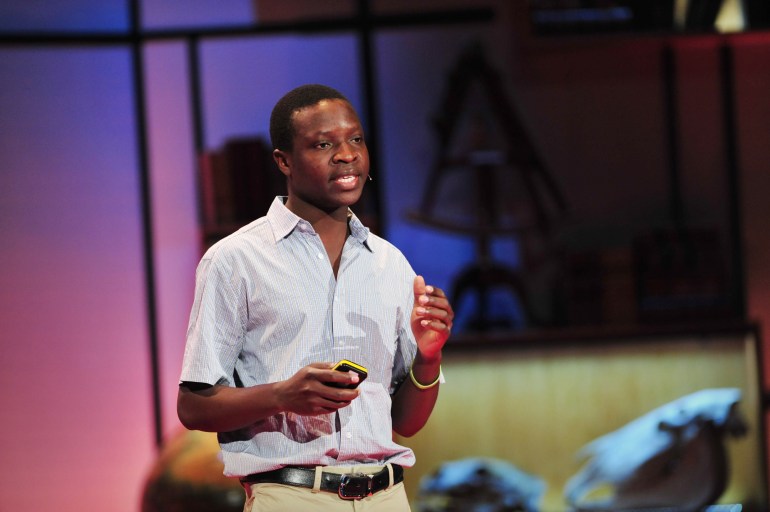
Here’s a story from my own life: When I first took over leadership of TED in late 2001, I was reeling from the near collapse of the company I had spent 15 years building, and I was terrified of another huge public failure. I had been struggling to persuade the TED community to back my vision for TED, and I feared that it might just fizzle out. Back then, TED was an annual conference in California, owned and hosted by a charismatic architect named Richard Saul Wurman, whose larger-than-life presence infused every aspect of the conference. About 800 people attended every year, and most of them seemed resigned to the fact that TED probably couldn’t survive once Wurman departed. The TED conference of February 2002 was the last to be held under his leadership, and I had one chance and one chance only to persuade TED attendees that the conference would continue just fine. I had never run a conference before, however, and despite my best efforts at marketing the following year’s event, only 70 people had signed up for it.
Early on the last morning of that conference, I had 15 minutes to make my case. And here’s what you need to know about me: I am not naturally a great speaker. I say “um” and “you know” far too often. I will stop halfway through a sentence, trying to find the right word to continue. I can sound overly earnest, soft spoken, conceptual. My quirky British sense of humor is not always shared by others.
I was so nervous about this moment, and so worried that I would look awkward on the stage, that I couldn’t even bring myself to stand. Instead I rolled forward a chair from the back of the stage, sat on it and began.
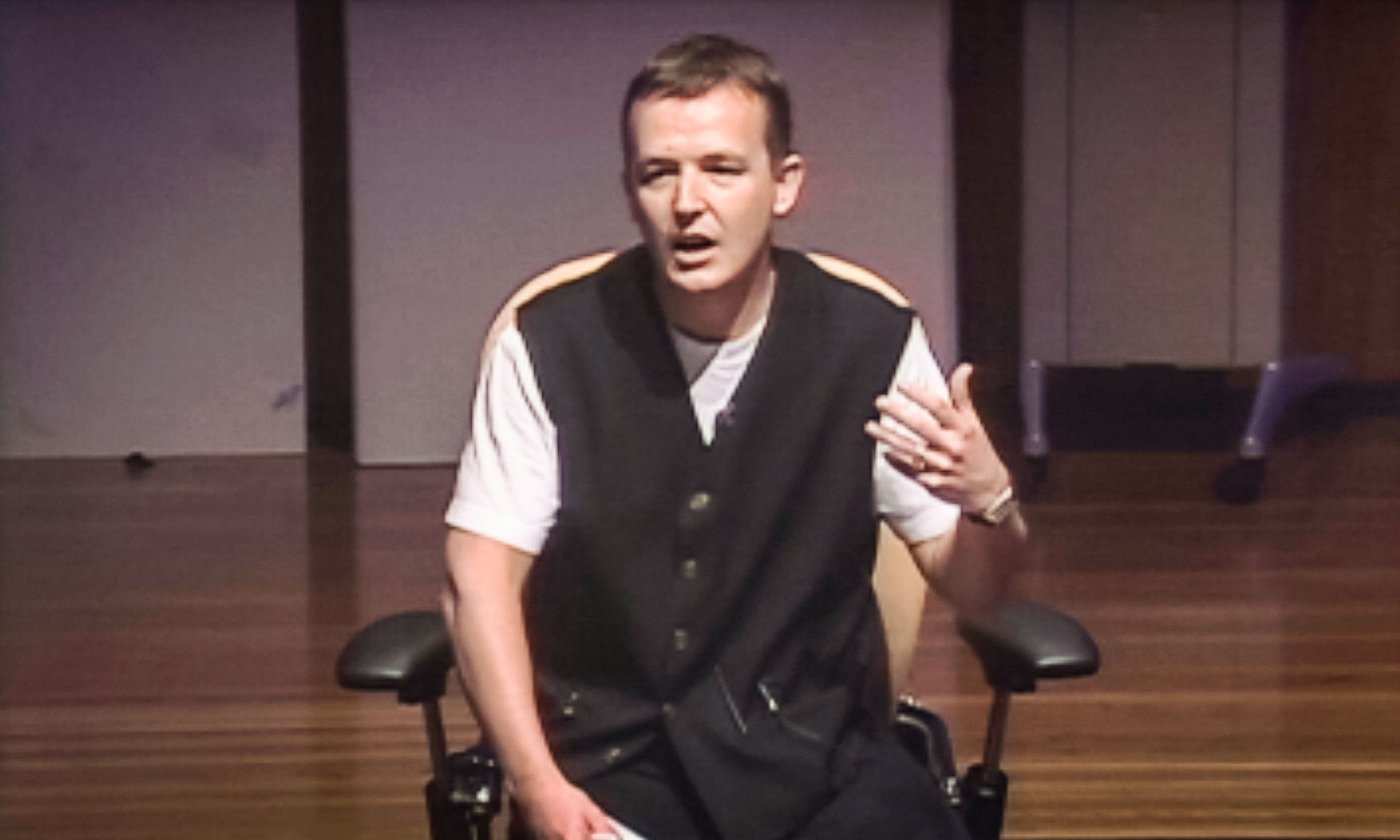
I look back at that talk now and cringe — a lot. If I were critiquing it today, there are a hundred things I would change, starting with the wrinkly white T-shirt I was wearing. And yet … I had prepared carefully what I wanted to say, and I knew there were at least some in the audience desperate for TED to survive. If I could just give those supporters a reason to get excited, perhaps they would turn things around. Because of the recent dotcom bust, many in the audience had suffered business losses as bad as my own. Maybe I could connect with them that way?
I spoke from the heart, with as much openness and conviction as I could summon. I told people I had just gone through a massive business failure. That I’d come to think of myself as a complete loser. That the only way I’d survived mentally was by immersing myself in the world of ideas. That TED had come to mean the world to me — that it was a unique place where ideas from every discipline could be shared. That I would do all in my power to preserve its best values. That, in any case, the conference had brought such intense inspiration and learning to us that we couldn’t possibly let it die … could we?
Oh, and I broke the tension with an apocryphal anecdote about France’s Madame de Gaulle and how she shocked guests at a diplomatic dinner by expressing her desire for “a penis.” In England, I said, we also had that desire, although there we pronounced it happiness and TED had brought genuine happiness my way.
To my utter amazement, at the end of the talk, Jeff Bezos, the head of Amazon, who was seated in the center of the audience, rose to his feet and began clapping. And the whole room stood with him. It was as if the TED community had collectively decided, in just a few seconds, that it would support this new chapter of TED after all. And in the 60-minute break that followed, some 200 people committed to buying passes for the following year’s conference, guaranteeing its success.
If that 15-minute talk had fizzled, TED would have died, four years before ever putting a talk on the Internet.
No matter how little confidence you might have today in your ability to speak in public, there are things you can do to turn that around. Facility with public speaking is not a gift granted at birth to a lucky few. It’s a broad-ranging set of skills. There are hundreds of ways to give a talk, and everyone can find an approach that’s right for them and learn the skills necessary to do it well.
Several years ago, TED’s content director, Kelly Stoetzel, and I went on a global tour in search of speaking talent. In Nairobi, Kenya, we met Richard Turere, a 12-year-old Maasai boy who had come up with a surprising invention. His family raised cattle, and one of the biggest challenges was protecting them at night from lion attacks. Richard had noticed that a stationary campfire didn’t deter the lions, but walking around waving a torch did seem to work. The lions were apparently afraid of moving lights! Richard had somehow taught himself electronics by messing around with parts taken from his parents’ radio. He used that knowledge to devise a system of lights that would turn on and off in sequence, creating a sense of movement. It was built from scrapyard parts — solar panels, a car battery and a motorcycle indicator box. He installed the lights and — presto! — the lion attacks stopped. News of his invention spread and other villages wanted in. Instead of seeking to kill the lions as they had done before, they installed Richard’s “lion lights.” Both villagers and pro-lion environmentalists were happy.
It was an impressive achievement but, at first glance, Richard certainly seemed an unlikely TED speaker. He stood hunched over in a corner of the room, painfully shy. His English was halting, and he struggled to describe his invention coherently. It was hard to imagine him on a stage in California in front of 1,400 people, slotted alongside Sergey Brin and Bill Gates.
But Richard’s story was so compelling that we went ahead anyway and invited him to come speak at TED (TED Talk: My invention that made peace with lions ). In the months before the conference, we worked with him to frame his story — to find the right place to begin, and to develop a natural narrative sequence. Because of his invention, Richard had won a scholarship to one of Kenya’s best schools, where he had the chance to practice his TED Talk several times in front of a live audience. This helped build his confidence to the point where his personality could shine through.

He got on an airplane for the first time in his life and flew to Long Beach, California. As he walked onto the TED stage, you could tell he was nervous, but that only made him more engaging. As Richard spoke, people were hanging on his every word, and every time he smiled, the audience melted. When he finished, people just stood and cheered.
Richard’s tale can encourage us all to believe we might be able to give a decent talk. Your goal is not to be Winston Churchill or Nelson Mandela. It’s to be you. If you’re a scientist, be a scientist; don’t try to be an activist. If you’re an artist, be an artist; don’t try to be an academic. If you’re just an ordinary person, don’t try to fake some big intellectual style; just be you. You don’t have to raise a crowd to its feet with a thunderous oration. Conversational sharing can work just as well. In fact, for most audiences, it’s a lot better. If you know how to talk to a group of friends over dinner, then you know enough to speak publicly.
And technology is opening up new options. We live in an age where you don’t have to be able to speak to thousands of people at a time to have an outsized impact. It could just be you talking intimately to a video camera, and letting the Internet do the rest.
Presentation literacy isn’t an optional extra for the few. It’s a core skill for the twenty-first century. It’s the most impactful way to share who you are and what you care about. If you can learn to do it, your self-confidence will flourish, and you may be amazed at the beneficial impact it can have on your success in life, however you might choose to define that.
If you commit to being the authentic you, I am certain that you will be capable of tapping into the ancient art that is wired inside us. You simply have to pluck up the courage to try.
Excerpted from the book TED Talks: The Official TED Guide to Public Speaking by Chris Anderson. © 2016 by Chris Anderson. Reproduced by permission of Houghton Mifflin Harcourt. All rights reserved.

About the author
Chris Anderson is the curator of TED.
- book excerpt
- Chris Anderson
- Jacqueline Novogratz
- Monica Lewinsky
- presentation literacy
- public speaking
- Richard Turere
- William Kamkwamba
TED Talk of the Day

How to make radical climate action the new normal

6 ways to give that aren't about money

A smart way to handle anxiety -- courtesy of soccer great Lionel Messi

How do top athletes get into the zone? By getting uncomfortable

6 things people do around the world to slow down

Creating a contract -- yes, a contract! -- could help you get what you want from your relationship

Could your life story use an update? Here’s how to do it

6 tips to help you be a better human now

How to have better conversations on social media (really!)

Let’s stop calling them “soft skills” -- and call them “real skills” instead

3 strategies for effective leadership, from a former astronaut

There’s a know-it-all at every job — here’s how to deal


The 7 types of people you need in your life to be resilient

Storytelling is a powerful communication tool — here’s how to use it, from TED

What’s the difference between shyness and introversion? And how can companies help introverts thrive? A Q&A with Susan Cain

Before your next presentation or speech, here's the first thing you must think about

Gallery: When reading is an act of daring

This website uses cookies
We place some essential cookies on your device to make this website work. We'd like to use additional cookies to remember your settings and understand how you use our services. This information will help us make improvements to the website.
Catalogue description Reading: Presentation College
Ordering and viewing options.
This record has not been digitised and cannot be downloaded.
This record is stored off site and will take four working days to be delivered to The National Archives.
You can order records in advance to be ready for you when you visit Kew . You will need a reader's ticket to do this. Or, you can request a quotation for a copy to be sent to you.
- Book a visit Order a copy
Have you found an error with this catalogue description? Let us know
Your details
If you provide contact details we may contact you if we need more information.
Help with your research
- How to use this catalogue
- Need more context? View the catalogue description for ED 109
Sign me up to the mailing list
Subscribe now for regular news, updates and priority booking for events

Find out more
- Jobs and careers
- Friends of The National Archives
- Website A-Z index
- Accessibility
- Podcasts and videos
- Image library
- UK Government Web Archive
- Legislation.gov.uk Opens a new window
- Find case law
- The Gazette Opens a new window
- Terms of use
- Privacy policy
- Freedom of Information
- Transparency
All content is available under the Open Government Licence v3.0 , except where otherwise stated
- For Educators
- For Students
Available Now: PowerPoints for Ten Steps to Improving College Reading Skills, 7/e
Latest news.

Giving presentations
- Introduction
Thinking about your audience
Planning your presentation, notes, handouts and visual aids, good slide design.
- Delivering your presentation
- Poster presentations
Useful links for giving presentations
- Presentations (online) A Study Advice guide to giving online presentations
- Study Advice Helping students to achieve study success with guides, video tutorials, seminars and one-to-one advice sessions.
- Presentation skills A Prezi on what to consider when planning and delivering a presentation from the University of East Anglia.
- Group work LibGuide Expert guidance on successful group work at university.
- Presentation skills for quivering wrecks by Bob Etherington Ebook (available to University of Reading members only). Aimed at business presenters, but good advice for all.
Good preparation is key to a good presentation. If you have considered your audience, know what messages you want to communicate, and have thought about the clearest way of communicating these messages, you can go into your presentation with confidence. Keeping things simple and not including too much in either your presentation itself, or your visual aids, means you will be able to pace your presentation well and your audience will appreciate the information you wish to communicate. The advice on this page shows you how to prepare a practically perfect presentation!

- Who will be in the audience? Students, lecturers, fellow researchers, experts in the field, business people, general public, a mixture?
- Consider your purpose – to inform, show progress, persuade, sell, disseminate results, teach, or introduce a new idea?
- Will your presentation be an overview, basic introduction, develop an existing idea, go over old ground from a new perspective, summarise information, challenge beliefs, or show something new?
It is difficult to take in a lot of detailed information when listening. Therefore, it is very important that your presentation has a clear structure so your audience can follow it.
In a 10-15 min presentation you will only have time to make 3 or 4 main points. You will have more impact if your points are clear, simple, relevant, and direct.
Beginning : Introduce yourself. Outline the aims of your talk and what you will cover in the presentation. Start with an attention grabber, such as a picture, an everyday example, or a rhetorical question.
Middle : Your points should lead logically from each other. What does the audience need to know first in order to understand your subject? Then what do they need to know? What evidence will you use to support these points and convince the audience? Have clear sections or headings to structure the middle section and lead from one point to another.
End : Avoid introducing new information at this point. Summarise the main things you want the audience to remember. End positively with a strong concluding sentence, not an apology. Leave time for questions. If you are presenting to an external audience, have your contact details available for people.
When preparing your material, think about what you will be comfortable saying – don't include anything that you aren't happy with or don't have confidence in. Do your research and check your facts so that you can feel secure in your knowledge. Steer clear of jokes and humour if it doesn't come naturally to you.
Planning a group presentation can take longer than you think, as you have to arrange times to meet and coordinate everyone's contributions. Use the links below to help you work out what you need to do to make your group presentation succeed.
- Group work LibGuide Expert guidance for successful group work at university.
Many people are tempted to write their presentation out fully and read it aloud, but this isn't enjoyable for the speaker or the audience; it is hard to get vocal expression and connection with the audience when reading aloud, and a written script is often more stilted and formal than natural speech. A better idea is to speak normally and use notes to guide you.
- It may be better to use a few file cards for your notes rather than a sheet of A4 paper – less flimsy and less tempting to hide behind!
- Use headings and key words to remind you of the main points and their order
- Less is more – you want to be able to read them quickly at a glance
- If you are using visual aids, note cues showing when you want to change slide
- You can write reminders to yourself – like "slow down" if you tend to talk fast
- Note down things you definitely don't want to get wrong: names, dates, statistics
- Number your cards in case they get mixed up or dropped.
If you have been asked to prepare a handout , don't try to include too much information or your audience will spend more time reading it than listening to you. Include:
- a brief outline of your talk
- a summary of data
- references and further reading on your topic
- contact details
There are also various visual aids you may use. The most commonly used include PowerPoint slides, Prezi, video clips and posters. You might also use a flipchart or whiteboard, or have some physical materials you want to show.
If you use visual aids, keep them simple and make sure that they support and add emphasis to your argument – not distract the audience from what you are saying. Whatever you use, make sure you know how to find and use any necessary technology or equipment.
Visual aids can give you confidence, help you to remember the structure of your talk and ensure that the audience does not look at you all the time. They should enhance and illustrate what you say, making it easier for the audience to understand and remember. They are not supposed to dominate or distract from your talk.
Here are some common options and issues you may need to consider:
PowerPoint slides
These are common and easy to use, but may take a few minutes to set up, so plan this into your timing. Ensure you have a backup plan in case the technology doesn't work on the day, such as having the slides on a memory stick as well as on the network drive, or having handouts of the slides to give out. Check you know how to change between slides using the mouse or a remote control. Beware of sound effects on animations!
Prezi (link below) is a non-linear alternative to PowerPoint. It provides templates that are often similar to mind-maps, and you are able to zoom in and out, and navigate round them in different ways. Be careful not to overdo the zooming and movement as it can be very disorientating for the audience. It is easy to get carried away with exploring the features of Prezi, meaning it can take far longer to prepare your presentation. However, if used well, Prezi can be a powerful presentation tool. Be aware that the free version of the software provides access to your presentations online, so there needs to be a reliable internet connection in the presentation venue.
Video clips
It can be effective to break a presentation up with a short video clip to illustrate a key point. There are many educational videos available on YouTube and via TED Talks (link below). However, make sure any videos are professional, appropriate, and relevant. Always ask yourself why you are using it and if you haven't got a good reason, leave it out. Check the sound, projection, and internet facilities in the presentation venue beforehand, and have an alternative plan in case the video won't play on the day.
Flip charts / white board
These are more suitable for small group discussions, as they simply can't be seen at the back of a large hall. Make sure you have non-permanent pens to write on the whiteboard. Also practice writing in large, clear letters so that it is easy to see.
Handouts can mean the audience doesn't have to copy down all the slides - but they can also be distracting, as people read them instead of listening. If you are presenting to a large audience (for instance at a conference) it can be expensive to provide handouts. Consider whether they can be sent via email or put on a website instead. If you're going to share them (or PowerPoint slides) electronically, it may be better to save them as PDFs.
Showing an object may be useful as a focus for discussion with a small group. It will work better as a replacement for part of your discussion (e.g. leave out some explanation) rather than reinforcing your message.
- Prezi Presentation software.
- TED talks Inspiring short educational talks.
Keep your slides simple, uncluttered, and easy to read. Just because you can have music, moving graphics, and bullet points whizzing in and out doesn't mean you have to! But if you're confident about your technical ability, some simple animation can be very effective.
30pt font and above is best for large audiences. Avoid distracting backgrounds, and keep lots of white space between lines/sections. Choose a writing colour that shows up clearly on the background (avoid green & red), and for a professional presentation, stick to simple fonts and avoid cartoons. Keep unnecessary punctuation to a minimum. If you're going to use images, make sure they are there for a reason - to illustrate your point or make it memorable.
For sources of copyright-cleared images, see the Library's list of image databases (link below).
It's a good idea to include a slide at the beginning of your presentation with your name and title, and follow this with a slide outlining your talk. End with a slide giving your contact details.
- Image and sound resources
- << Previous: Home
- Next: Delivering your presentation >>
- Last Updated: Sep 25, 2023 10:01 AM
- URL: https://libguides.reading.ac.uk/presentations

- Discussions

Antony Little

Rhythm Pharmaceuticals Inc.

Richard Knight

Chb Journal

Joseph Kelly
- Presentation College
- Prospective Students
- New & Current Students
- External Links
75+ years of teaching excellence.
75+ years of teaching excellence..

Teach. Learn. Grow.
Latest highlights.

Cooper credits fitness and desire for T&T U-17 result

Race for top four of SSCL Premiership still on

Presentation College San Fernando, Fatima battle for top spot in SSCL

Presentation College student Marcus McDonald wins Jr Calypso Monarch
The fox and the monk, letter from the principal, things to explore.

College Sports

The Premier all Inclusive event in South.

Famous profound personalities are all part of our #P2BP History!
Special activities & features, college hydroponics, go carting form activity, college auditorium activity, media releases.

Get in touch
Subscribe to our newsletter.

Our History
Additional links.
- Career Guidance
- rePRESent – Local Reunion
- Prestige Fete
Helpful Info
- Clubs Schedules
- Virtual Campus Tour
Copyright © 2023 Presmen.org | Designed by CariWebs | Hosting sponsored by Browwwsers | Maintained by College and Alumni teams.


Want to create or adapt books like this? Learn more about how Pressbooks supports open publishing practices.
7.4 Public Speaking and Class Presentations
Learning objectives.
- Know how to overcome nervousness and anxiety associated with public speaking and giving class presentations.
- Effectively use the six-step process to prepare for and deliver a class presentation.
- Create effective visual aids for use in class presentations.
- Work with a group to successfully plan and deliver a class presentation.
Public speaking—giving an oral presentation before a class or another group of people—is a special form of interaction common in education. You will likely be asked to give a presentation in one of your classes at some point, and your future career may also involve public speaking. It’s important to develop skills for this form of communication.
Public speaking is like participating in class—sharing your thoughts, ideas, and questions with others in the group. In other ways, however, public speaking is very different. You stand in front of the class to speak, rather than from your usual seat—and for most students, that changes the psychology of the situation. You also have time outside of class to prepare your presentation, allowing you to plan it carefully—and, for many, giving more time to worry about it and experience even more anxiety!
Overcoming Anxiety
Although a few people seem to be natural public speakers, most of us feel some stage fright or anxiety about having to speak to a group, at least at first. This is completely normal. We feel like everyone is staring at us and seeing our every flaw, and we’re sure we’ll forget what we want to say or mess up. Take comfort from knowing that almost everyone else is dreading giving class presentations the same as you are! But you can learn to overcome your anxiety and prepare in a way that not only safely gets you through the experience but also leads to success in your presentation. The following are proven strategies for overcoming anxiety when speaking in public:
- Understand anxiety. Since stage fright is normal, don’t try to deny that you’re feeling anxious. A little anxiety can help motivate you to prepare and do your best. Accept this aspect of the process and work to overcome it. Anxiety is usually worst just before you begin and but eases up once you’ve begun.
- Understand that your audience actually wants you to succeed. They’re not looking for faults or hoping you’ll fail. Other students and your instructors are on your side, not your enemy. They likely won’t even see your anxiety.
- Reduce anxiety by preparing and practicing. The next section discusses the preparation process in more detail. The more fully you prepare and the more often you have practice, the more your anxiety will go away.
- Focus on what you’re saying, not how you’re saying it. Keep in mind that you have ideas to share, and this is what your classmates and instructors are interested in. Don’t obsess about speaking, but focus on the content of your presentation. Think, for example, of how easily you share your ideas with a friend or family member, as you naturally speak your mind. The same can work with public speaking if you focus on the ideas themselves.
- Develop self-confidence. As you prepare, you will make notes you can refer to during the presentation. You’re not going to forget what you want to say. The more you practice, the more confident you’ll become.
Guidelines for Presentations
Preparing and delivering a presentation in class (or in business or other settings) is a process very similar to the learning process discussed in Chapter 4 “Listening, Taking Notes, and Remembering” , Chapter 5 “Reading to Learn” , and Chapter 6 “Preparing for and Taking Tests” and the writing process discussed in Chapter 8 “Writing for Classes” . The process breaks down into these six basic steps:
- Analyze your audience and goals
- Plan, research, and organize your content
- Draft and revise the presentation
- Prepare speaking notes
- Practice the presentation
- Deliver the presentation
Step 1: Analyze Your Audience and Goals
Who will see and hear your presentation—and why? Obviously, other students and the instructor. But you still need to think about what they already know, and don’t know, about your topic. If your topic relates to subject matter in class lectures and readings, consider what background information they already have and be careful not to give a boring recap of things they already know. It may be important, however, to show how your specific topic fits in with subjects that have been discussed already in class, especially in the beginning of your presentation, but be sure to focus on your new topic.
New terms and concepts may become familiar to you while doing your research and preparation, but remember to define and explain them to other students. Consider how much explanation or examples will be needed for your audience to grasp your points. If your topic involves anything controversial or may provoke emotion, consider your audience’s attitudes and choose your words carefully. Thinking about your audience will help you find ways to get their attention and keep them interested.
Be sure you are clear about the goals for the presentation. Are you primarily presenting new information or arguing for a position? Are you giving an overview or a detailed report? Review the assignment and talk with the instructor if you’re unsure. Your goals guide everything in the presentation: what you say, how much you say, what order you say it in, what visual aids you use, whether you use humor or personal examples, and so forth.
Step 2: Plan, Research, and Organize Your Content
Starting with the assignment and your goals, brainstorm your topic. Jot notes on specific topics that seem important. Often you’ll do reading or research to gather more information. Take notes as you would with any reading. As you research the topic at this stage, don’t worry at first about how much content you are gathering. It’s better to know too much and then pick out the most important things to say than to rush ahead to drafting the presentation and then realize you don’t have enough material.
Organizing a presentation is similar to organizing topics in a class paper and uses the same principles. Introduce your topic and state your main idea (thesis), go into more detail about specific ideas, and conclude your presentation. Look for a logical order for the specifics in the middle. Some topics work best in chronological (time) order or with a compare-and-contrast organization. If your goal is to persuade the audience, build up to the strongest reason. Put similar ideas together and add transitions between different ideas.
While researching your topic and outlining your main points, think about visual aids that may help the presentation.
Also start thinking about how much time you have for the presentation, but don’t limit yourself yet in the outline stage.
Step 3: Draft and Revise the Presentation
Unless required by the assignment, you don’t need to actually write out the presentation in full sentences and paragraphs. How much you write depends on your own learning and speaking style. Some students speak well from brief phrases written in an outline, while other students find it easier to write sentences out completely. There’s nothing wrong with writing the presentation out fully like a script if that helps you be sure you will say what you intend to—just so you don’t actually get up and read from the script.
You can’t know for sure how long a presentation will last until you rehearse it later, but you can estimate the time while drafting it. On the average, it takes two to three minutes to speak what can be written on a standard double-spaced page—but with visual aids, pauses, and audience interaction, it may take longer. While this is only a rough guide, you can start out thinking of a ten-minute presentation as the equivalent of a three to four-page paper.
Never wait until the last minute to draft your presentation. Arrange your time to prepare the first draft and then come back to it a day or two later to ask these questions:
- Am I going on too long about minor points? Could the audience get bored?
- Do I have good explanations and reasons for my main points? Do I need more data or better examples? Where would visual aids be most effective?
- Am I using the best words for this topic and this audience? Should I be more or less informal in the way I talk?
- Does it all hold together and flow well from one point to the next? Do I need a better introduction or transition when I shift from one idea to another?
Visual Aids in Presentations
Except for very short informal presentations, most presentations gain from visuals—and visual aids are often expected. If encouraged or allowed to include visuals in your presentation, plan to do so. Consider all possible types:
- Charts or graphs
- Photos or other images
- Video clips
- Handouts (only when necessary—they can be distracting)
Use the available technology, whether it’s an overhead projector, PowerPoint slides, a flip chart, or posters. (Talk to your instructor about resources and software for designing your visuals.) Follow these guidelines:
Design your visuals carefully. Here are some basic rules:
- Use a simple, neutral background. A light-colored background with text in a dark color works best for words; a dark background used like matting works best for photos.
- Minimize the amount of text in visuals—more than eight words per slide is usually too much. Avoid simply presenting word outlines of what you are saying. Make sure text is large enough for the audience to read.
- Don’t use more than two pictures in a slide, and use two only to make a direct comparison. Montages are hard to focus on and distract the viewer from what you’re saying. Use images only when they support your presentation; don’t use clip art just as decoration.
- Don’t put a table of numbers in a visual aid. If you need to illustrate numerical data, use a graph. (Microsoft Excel can make them for you easily.)
- Don’t use sound effects. Use a very brief recording only if directly related to your main points.
- Don’t use visual special effects such as dissolves, spins, box-outs, or other transitions. They are distracting. Use animation sparingly and only if it helps make a point.
- Don’t use so many visuals or move through them so quickly that the audience gives all its attention to them rather than to you.
- Practice your presentation using your visual aids, because they affect your timing.
- Explain visuals when needed but not when they’re obvious.
- Keep your eyes on your audience, only briefly glancing at visuals to stay in synch with them.
- Don’t hand out a printout of your visuals. Your audience should keep their eyes on you instead of fiddling around with paper.
Step 4: Prepare Speaking Notes
As mentioned earlier, it’s not a good idea to read your presentation from a written page rather than deliver it. To keep your audience’s attention, it’s important to make eye contact with them and to use a normal speaking voice—and you can’t do this if you keep your eyes on a written script.
Speaking notes are a brief outline for your presentation. You might write them on index cards or sheets of paper. Include important facts and data as well as keywords for your main ideas, but don’t write too much. (If you forget things later when you start practicing, you can always add more to your outline then.) Be sure to number your cards or pages to prevent a last-minute mix-up.
Think especially about how to open and close your presentation, because these two moments have the most impact of the whole presentation. Use the opening to capture the audience’s attention, but be sure it is appropriate for your audience and the goals. Here are some possibilities for your opening:
- A striking fact or example (illustrating an issue or a problem)
- A brief interesting or humorous anecdote (historical, personal, or current event)
- A question to the audience
- An interesting quotation
Then relate the opening to your topic and your main point and move into the body of the presentation.
Your closing mirrors the opening. Transition from your last point to a brief summary that pulls your ideas together. You might end with a challenge to the audience, a strong statement about your topic, or a personal reflection on what you have been saying. Just make sure you have a final sentence planned so that you don’t end up uncomfortably fumbling around at the end (“Well, I guess that ends my presentation”).
Step 5: Practice the Presentation
Practice may be the most important step. It is also the best way to get over stage fright and gain confidence.
Practice first in an empty room where you imagine people sitting, so that you can move your eyes around the room to this “audience.” The first time through, focus on putting your outlined notes into full sentences in your natural speaking voice. Don’t read your notes aloud. Glance down at your notes only briefly and then look up immediately around the room. Practice two or three times just to find the right words to explain your points and feel more comfortable working with your notes. Time yourself, but don’t obsess over your presentation being the exact length required. If your presentation is much too long, however, adjust it now in your notes so that you don’t start memorizing things that you might accidentally still say later on even though you cut them from your notes.
Once you feel good speaking from your notes, practice to add some more polish to your delivery. You might want to record or videotape your presentation or ask a friend or roommate to watch your presentation. Pay attention to these aspects of how you speak:
- Try to speak in your natural voice, not in a monotone as if you were just reading aloud. If you will be presenting in a large room without a microphone, you will need to speak louder than usual, but still try to use a natural voice.
- In usual conversation, we speed up and slow down and vary the intensity of our words to show how we feel about what we’re saying. Practice changes in your delivery style to emphasize key points.
- Don’t keep looking at your notes. It’s fine if you use words that are different from those you wrote down—the more you rehearse without looking at your notes, the more natural sounding you will be.
- Be sure you can pronounce all new words and technical terms correctly. Practice saying them slowly and clearly to yourself until you can say them naturally.
- Don’t forget transitions. Listeners need a cue when you’re moving to a new idea. Practice phrases such as “ Another important reason for this is…” or “Now let’s move on to why this is so.…”
- Watch out for all those little “filler” words people use so often, such as “like,” “you know,” “well,” and “uh.” They’re very distracting to most audiences. Listen to or watch your tape to see if you are using these fillers or ask your friend to point it out.
- Pay attention to body language when practicing. Stand up straight and tall in every practice session so that you become used to it. Unless you have to stand at a podium to use a fixed microphone in your presentation, practice moving around while you speak; this helps keep the audience watching you. Use hand and arm gestures if they are natural for you, but don’t try to make up gestures for the presentation because they will look phony. Most important, keep your eyes moving over the audience. Practice smiling and pausing at key points.
- Finally, it’s a good idea to be ready in case of an accident. Most likely your presentation will go smoothly, you’ll stay on track with your notes, and your PowerPoint slides will work fine, but sometimes a mishap happens. Be ready to joke about it, rather than becoming flustered. If the computer fails and you lose your visuals, say something like, “Well, that’s a shame, I had some really great photos to show you!” If you drop your index cards or notes, or accidentally skip ahead in your presentation and then have to backtrack, make a joke: “Sorry about that, I was so excited to get to my next point that I’m afraid I lost control there for a moment!” Let your audience laugh with you—they’ll still be on your side, and you can defuse the incident and move on without becoming more nervous.
Step 6: Deliver the Presentation
Be sure to get enough sleep and eat a healthy breakfast. Don’t drink too much caffeine or else you’ll become hyper and nervous. Wear your favorite—and appropriate—clothing and comfortable shoes.
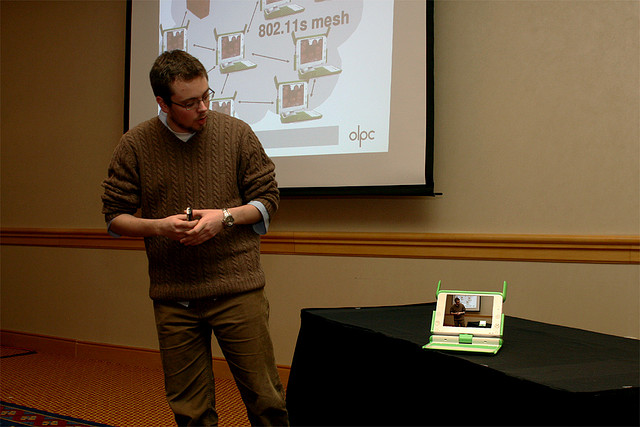
You may use computerized visual aids when you give a presentation to a class.
John Haynes Photography – OLPC – CC BY-ND 2.0.
Remember, your audience is on your side! If you’re still nervous before your turn, take a few deep breaths. Rehearse your opening lines in your mind. Smile as you move to the front of the room, looking at your audience. You’ll see some friendly faces smiling back encouragingly. As you start the presentation, move your eyes among those giving you a warm reception—and if you see some student looking bored or doing something else, just ignore them. But don’t focus on any one person in the audience for too long, which could make them nervous or cause them to look away.
Don’t keep looking at your watch or a clock: If your rehearsal times were close to your assigned time, your presentation will be also. If you do notice that you’re running behind schedule, it may be that you’re saying too much out of nervousness. Use your notes to get back on track and keep the pace moving. But it’s better to deliver your presentation naturally and fluidly and be a bit long or short than to try to change your words and end up sounding unnatural.
At the closing, deliver your last line with confidence, sweeping your eyes over the audience. If appropriate, ask if there are any questions. When you’re done, pause, smile, say “Thank you,” and walk back to your seat.
Later on, ask other students and your instructor for comments. Be open minded—don’t just ask for praise. If you hear a suggestion for improvement, file that in your memory for next time.
Group Presentations
You may be assigned to give a presentation in a small group. The six-step process discussed previously works for group presentations, too, although group dynamics often call for additional planning and shared responsibilities:
- Schedule a group meeting as soon as possible to get started. Don’t let another student put things off. Explain that you’re too busy and won’t have time at the last minute.
- Begin by analyzing your audience and your goals together as a group to make sure everyone understands the assignment the same. Discuss who should do what. While everyone should talk about what content to include, from here onward, you will take on specialized roles. One or more may begin research and gathering information. Others who are good writers may volunteer to draft the presentation, while one or more others may develop the visual aids. Those who have public speaking experience may volunteer to do all or most of the speaking (unless the assignment requires everyone to have a speaking role). You also need a team leader to keep everyone on schedule, organize meetings, and so on. The best team leader is an even-tempered student with good social skills, who can motivate everyone to cooperate.
- Steps 2 and 3 can likely be carried out individually with assigned tasks, but group members should stay in touch. For example, the person developing the visuals should be talking to those doing the researching and drafting to see what visuals are needed and get started finding or creating them.
- Before preparing notes in step 4, meet again to go over the content and plan for visuals. Everyone should be comfortable with the plan so far. Make final decisions about who will do each section of the presentation. Set the time for each segment. Then speakers should prepare their own speaking notes. Let someone with strong speaking skills open or close the presentation (or both), with others doing the other parts.
- The whole group should be present for practice sessions in step 5, even if not everyone is speaking. Those not speaking should take notes and give feedback. If one student is doing most of the presenting, an alternate should be chosen in case the first choice is sick on the scheduled day. The alternate also needs to practice.
- During the delivery, especially if using technology for visual aids, one student should manage the visuals while others do the presenting. If several students present different segments, plan the transition from one to another so that the presentation keeps flowing without pauses.
Additional Resources
For Class Presentations
Using PowerPoint. A step-by-step illustrated tutorial for learning how to create effective visual presentations with PowerPoint. https://www.baruch.cuny.edu/tutorials/powerpoint/
“How to Give a Bad Talk.” A humorous look (with some very good advice) on what not to do when preparing for and giving a class presentation. http://www.cs.berkeley.edu/~pattrsn/talks/BadTalk.pdf
Class presentations on YouTube. Search YouTube with the phrase “class presentation” and look for video examples of actual students giving class presentations. Observing and critiquing the presentations of other students are good ways to get started preparing your own and learning from others. Here’s a good example of a student group presentation on a topic we can all relate to (how body language works):
In this presentation, take note of
- how students make good eye contact with the audience;
- the first student’s natural speaking voice and tone, and how she did not have to use her note cards very often (obviously she practiced well);
- some differences among these students;
- the use of PowerPoint slides within the presentation (some better than others);
- the appropriate occasional use of humor;
- the division of presentation responsibilities within the student group;
- each presenter’s interaction with the audience.
Key Takeaways
- Public speaking skills are important because you will likely give presentations in class and perhaps in a future job.
- Overcome anxiety about public speaking by understanding your feelings, preparing well and practicing your delivery, and focusing on your subject.
Follow a six-step process to prepare and deliver a presentation:
- Deliver the presentation and seek feedback
- Use visual aids to support a presentation, creating visuals that are relevant, attractive, and powerful.
- The success of a group presentation depends on effective group meetings, successful division of roles, and repeated group practices.
Checkpoint Exercises
If you have given a class presentation in the past, what worked best for you? (If you have not given a presentation yet as a student, what aspect do you think will be most difficult for you?)
__________________________________________________________________
Name the two most important things you can do to reduce anxiety about a class presentation you will have to give.
For each of the following statements about class presentations, circle T for true or F for false:
Describe how best to use body language (facial expressions, eye movements, gestures, etc.) when giving a presentation.
If you were assigned along with three other students to give a group presentation in the class using this textbook, what would be your preferred role in the preparation stages? Your least preferred role? If you had to take your least preferred role, what single thing would you want to work hardest on to make the presentation successful?
College Success Copyright © 2015 by University of Minnesota is licensed under a Creative Commons Attribution-NonCommercial-ShareAlike 4.0 International License , except where otherwise noted.
- About Paddington in Peru
- Postcards from Peru
- Meet the Characters
- Recent publications
- Picture books
- The Illustrators
- Our publishers
- #PawsWith Paddington
- Who is Paddington?
- Plush History
- Original BBC TV
- Immersive Experience London, UK
- Hotel Promotions

- UK/INTERNATIONAL USA RRRRHH FRANCE JP

Michael Bond, the creator of Paddington
"When I was small I never went to bed without a story. But I doubt my mother ever pictured me writing for a living. In fact, when I eventually gave up working for the BBC in order to write full time, I think both my parents were worried that I had given up a nice, safe job for what sounded to them like a very precarious existence."
Michael Bond was born in Newbury, Berkshire, England on 13th January 1926. He was educated at Presentation College, Reading. During World War II Michael Bond served in both the Royal Air Force and the Middlesex Regiment of the British Army.
He began writing in 1945 and sold his first short story to a magazine called London Opinion. This experience helped him decide that he wanted to be a writer.
It was while Michael Bond was working as a television cameraman for the BBC that he first came up with the idea for Paddington and he recalls in his own words how this came about:
"I bought a small toy bear on Christmas Eve 1956. I saw it left on a shelf in a London store and felt sorry for it. I took it home as a present for my wife Brenda and named it Paddington as we were living near Paddington Station at the time. I wrote some stories about the bear, more for fun than with the idea of having them published. After ten days I found that I had a book on my hands. It wasn’t written specifically for children, but I think I put into it the kind things I liked reading about when I was young."
Michael Bond sent the book to his agent, Harvey Unna, who liked it and after sending it to several publishers it was eventually accepted by William Collins & Sons (now Harper Collins). The publishers commissioned an illustrator, Peggy Fortnum, and the very first book "A Bear Called Paddington" was published on 13th October 1958. After the first Paddington book was accepted, Michael Bond went on to write a whole series and by 1965 his books were so successful that that he was able to give up his job with the BBC in order to become a full-time writer.
Since the first publication the Paddington books have sold more than thirty-five million copies worldwide and have been translated into over forty different languages, including Latin.
With his extraordinary flair for developing characters, Michael Bond has written much more besides Paddington including children’s television series The Herbs, books about a guinea pig called Olga da Polga and a series of adult novels about a French detective turned food guide inspector, Monsieur Pamplemousse. In total Michael Bond has written almost 150 books, including his autobiography 'Bears and Forebears'.
In 1997 Michael Bond was awarded an OBE for services to children’s literature and this was followed by a CBE in the Queen's Birthday Honours in 2015.
For the last 37 years of his life Michael Bond lived in London, not far from Paddington Station where it all began. He continued to write until shortly before he died on 27 th June 2017, aged 91.
On 13th January 2016 Michael Bond celebrated his 90th birthday. A few fans, and a couple of well known faces, got together to wish him many happy returns. You can see the short clip below:
Thank you to everyone who contributed - we hope you enjoy it!
- AI Generator
Sorry, your search returned zero results for “presentation_college_reading”
Have you tried doing the following:
Check for spelling errors or typos
Clear search filter options
Use fewer keywords
Got any suggestions?
We want to hear from you! Send us a message and help improve Slidesgo
Top searches
Trending searches

teacher appreciation
11 templates

17 templates

el salvador
32 templates

summer vacation
19 templates

27 templates
Reading Presentation templates
From learning how to read, to spending time with a good book and a cup of tea, reading can be an incredibly rewarding hobby. with the love for learning that reading provides, one can engage in activities like solving puzzles and crosswords, joining book clubs and creativity classes with friends, or learning new skills through instructional texts. these templates focus on this amazing skill, how to acquire it and how to enjoy it. discover them and prepare educative lessons that encourage students to love books.

Reading Workshop
Are you preparing a workshop and your goal is to stimulate reading habits in little kids? Then this template will make them interested in joining your classes. The illustrations depict situations where books take us to a different world. Space is a theme we love at Slidesgo, so the details...

Premium template
Unlock this template and gain unlimited access
Strategies for Studying Texts
Studying texts is an essential aspect of academic life, and it's a skill that can be challenging to master. Strategies for studying texts are crucial to understanding and retaining information, which is critical for success in exams and coursework. You've mastered them and now you're ready to share them with...
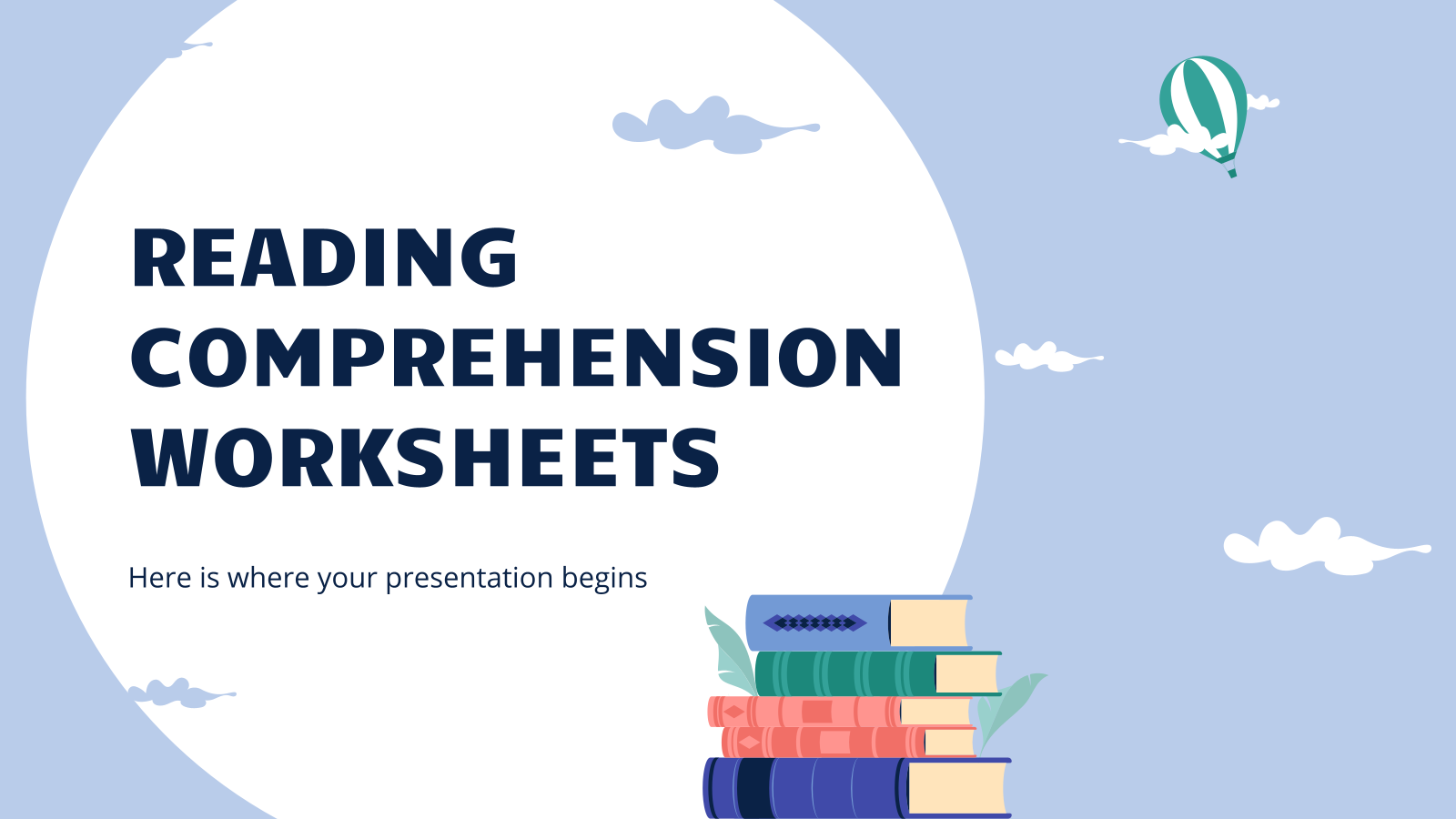
Reading Comprehension Worksheets
Resources for education, that's one of the things we like to create at Slidesgo! Whenever you think literature class is boring, try this template and see if we can change your mind. The theme of this presentation is reading comprehension, which means you can use it to check whether your...
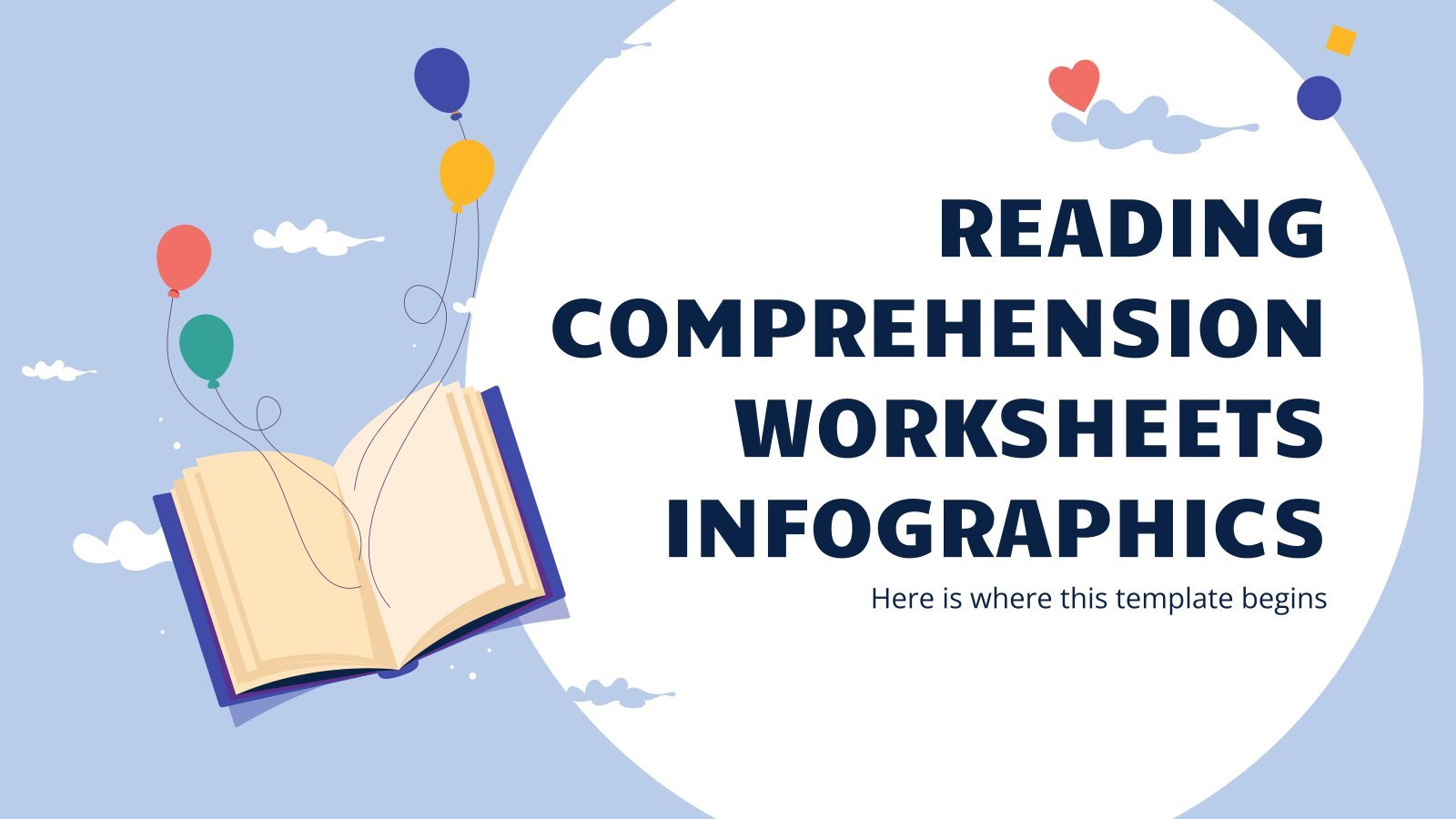
Reading Comprehension Worksheets Infographics
Reading comprehension is a fiddly subject for many students and teachers alike. What exactly are you supposed to comprehend? And at a sentence level or at a global level, and what is the difference? Now you can use this beautiful, simple set of infographics to explain all the nooks and...
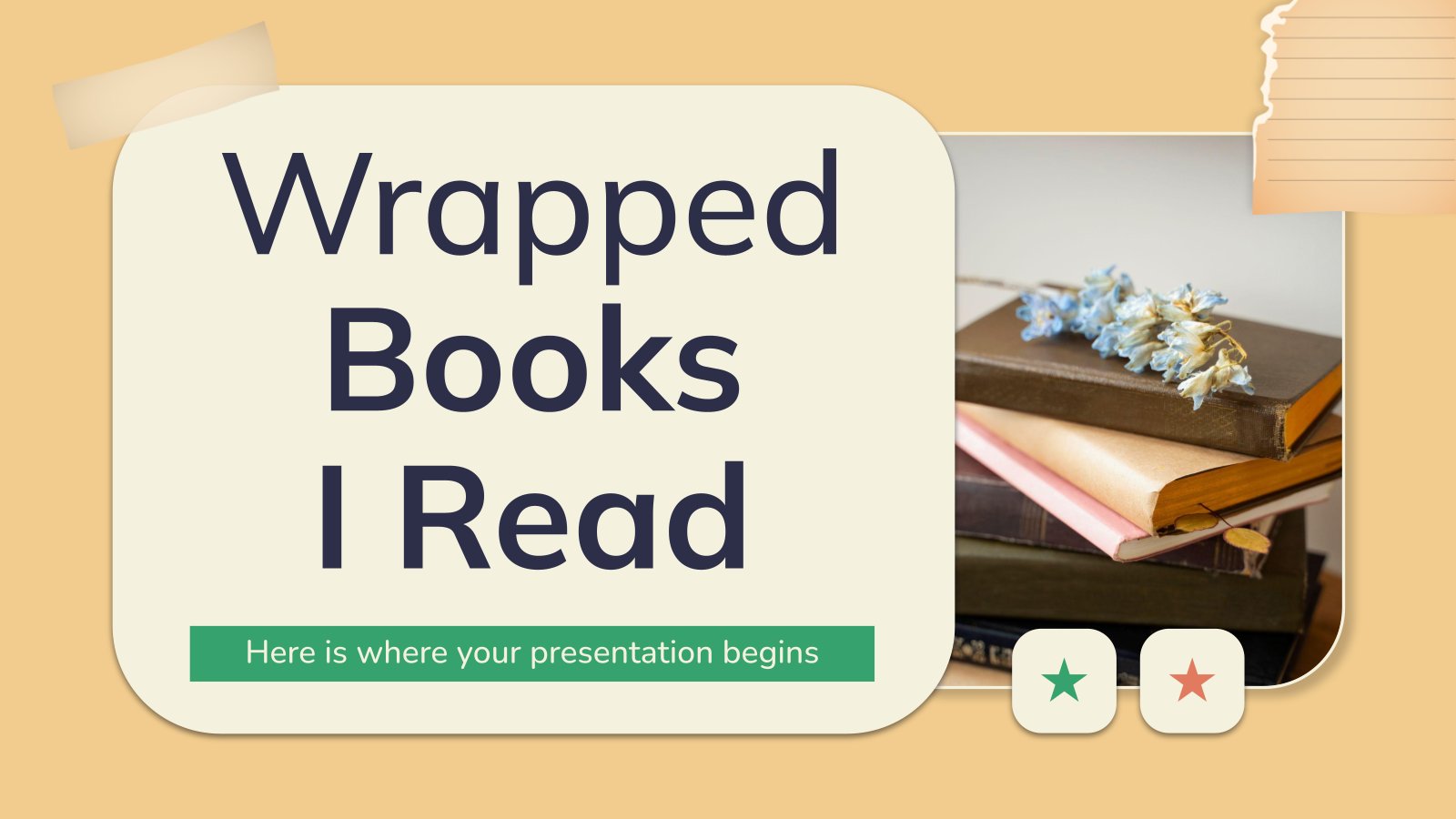
Wrapped Books I Read
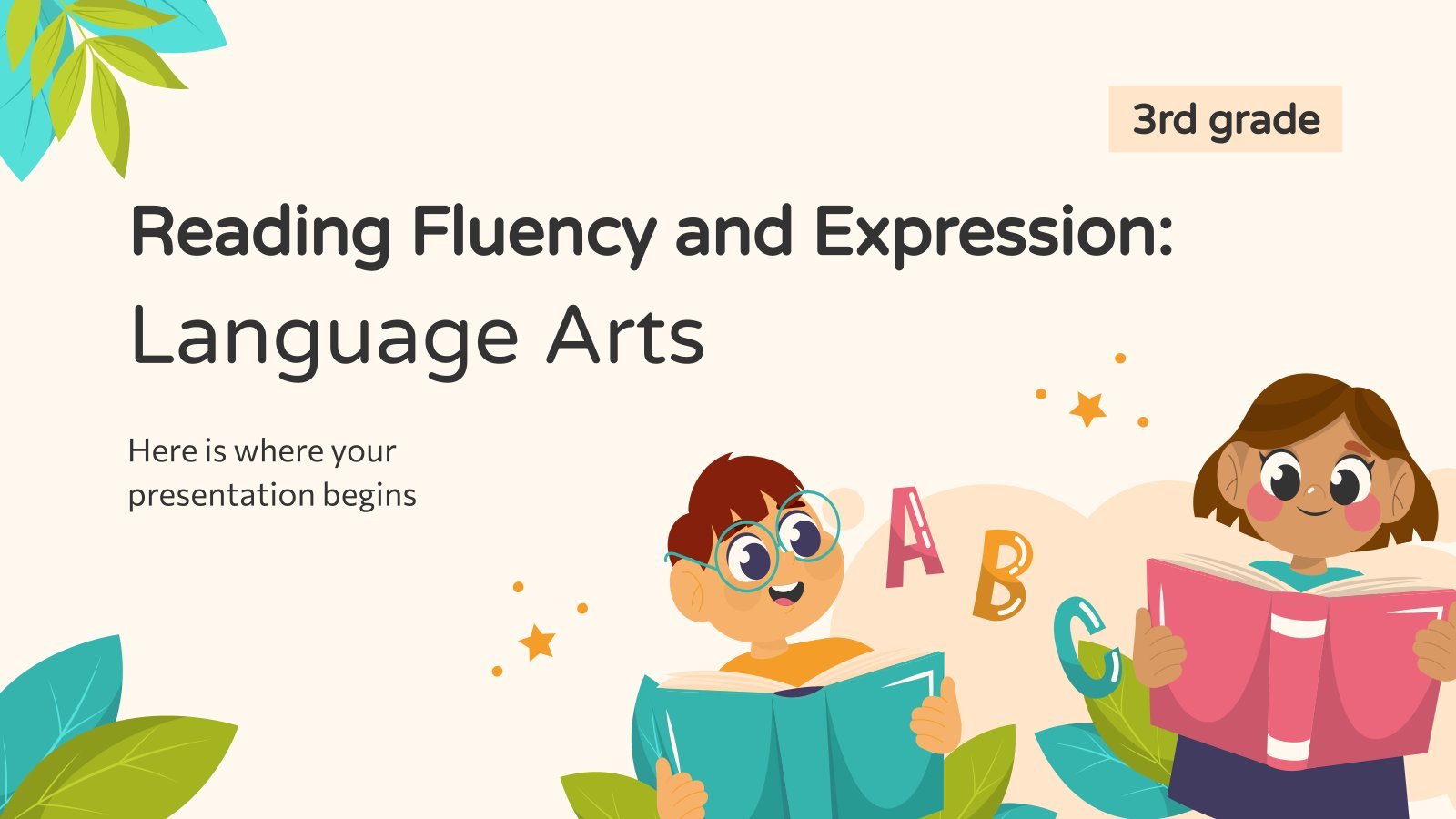
Reading Fluency and Expression - Language Arts - 3rd Grade
Introduce your 3rd grade students to the exciting world of reading fluency and expression with this creative and colorful template! This simple yet captivating design will engage even the youngest minds in the classroom, while providing them with the skills they need to become strong readers. With icons, graphs, and...
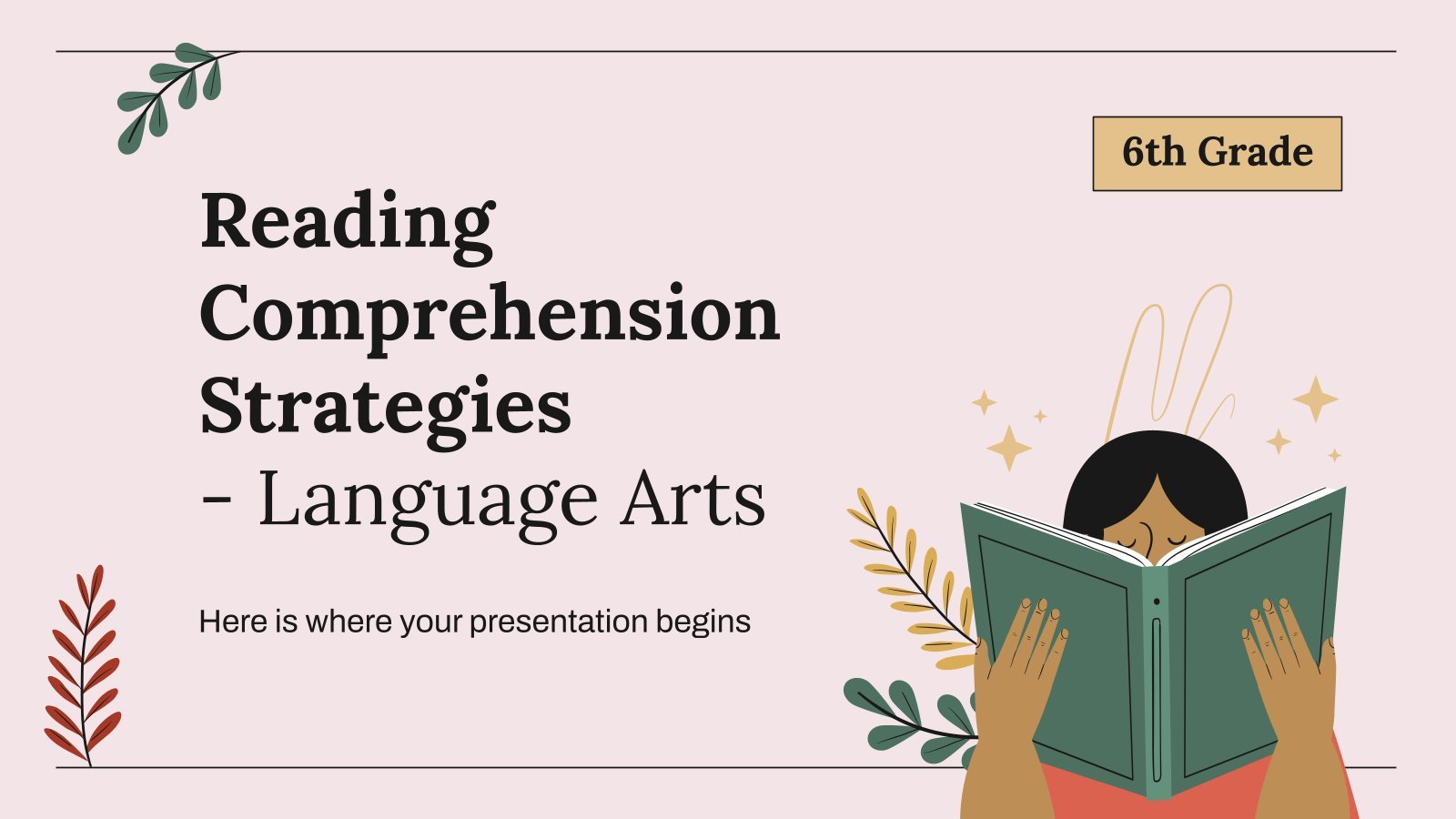
Reading Comprehension Strategies - Language Arts - 6th Grade
Ignite a love for reading and understanding with this vibrant presentation template. Featuring Google Slides and PowerPoint compatibility, the package is fully adjustable to suit your teaching requirements. It's filled with delightful illustrations that are sure to captivate young learners! From summarizing tips to key details identification, every essential strategy...
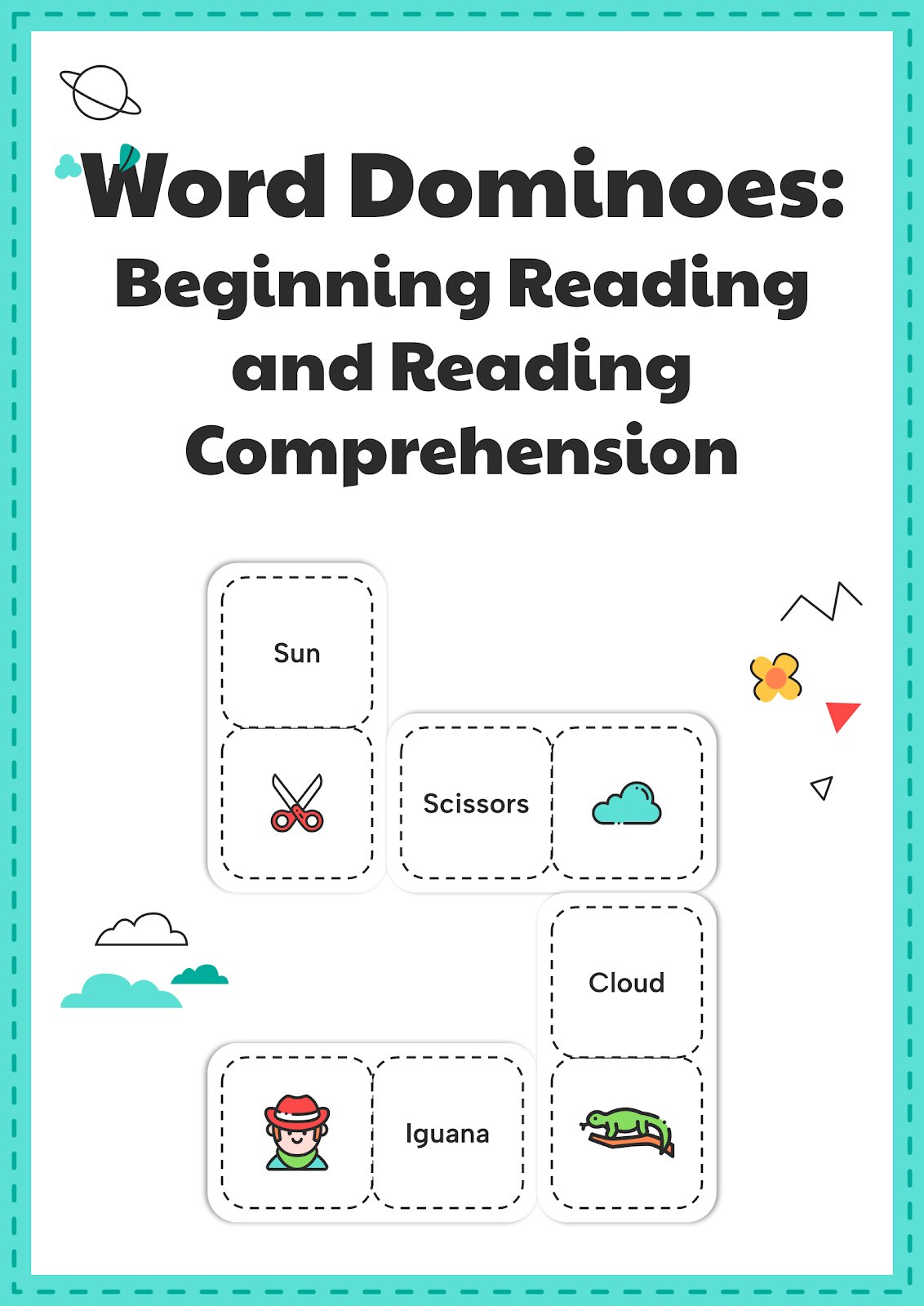
Word Dominoes: Beginning Reading and Reading Comprehension
Download the "Word Dominoes: Beginning Reading and Reading Comprehension" presentation for PowerPoint or Google Slides and teach with confidence. Sometimes, teachers need a little bit of help, and there's nothing wrong with that. We're glad to lend you a hand! Since Slidesgo is committed to making education better for everyone,...
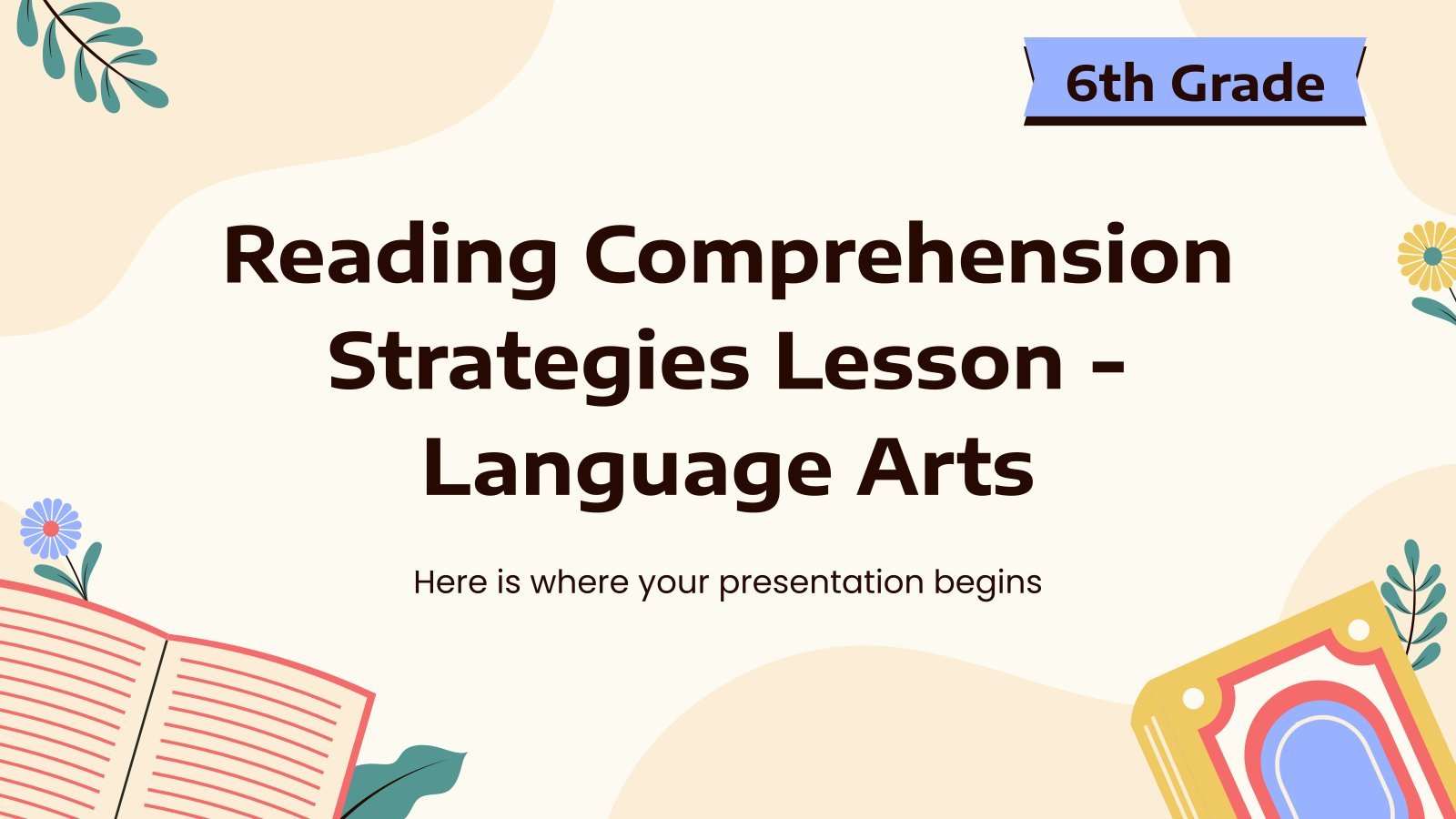
Reading Comprehension Strategies Lesson - Language Arts - 6th Grade
Transform dull reading comprehension lessons into engaging and challenging experiences! When it comes to fostering superior reading skills, this fully editable Google Slides and PowerPoint template is a game changer. Showcased in creamy yellow hues and adorned with fun book illustrations, this teaching aid is both effective and engaging. Packed...

I Love Reading
If the message that you want to convey is "I love reading", then we must simply agree and say "great!" Reading is a fun activity, and books are a source of knowledge and entertainment. How about you get a template like this one and create a presentation where you talk...

Reading Fluency and Comprehension Lesson - Language Arts - 7th Grade
"This template has been created by graphic design experts. It features aquamarine green backgrounds with adorable watercolor painted illustrations of children interacting with books." Now for some reading comprehension questions! Who designed the template? What color are the backgrounds? Ah! Are you the teacher? Then we can only recommend the...
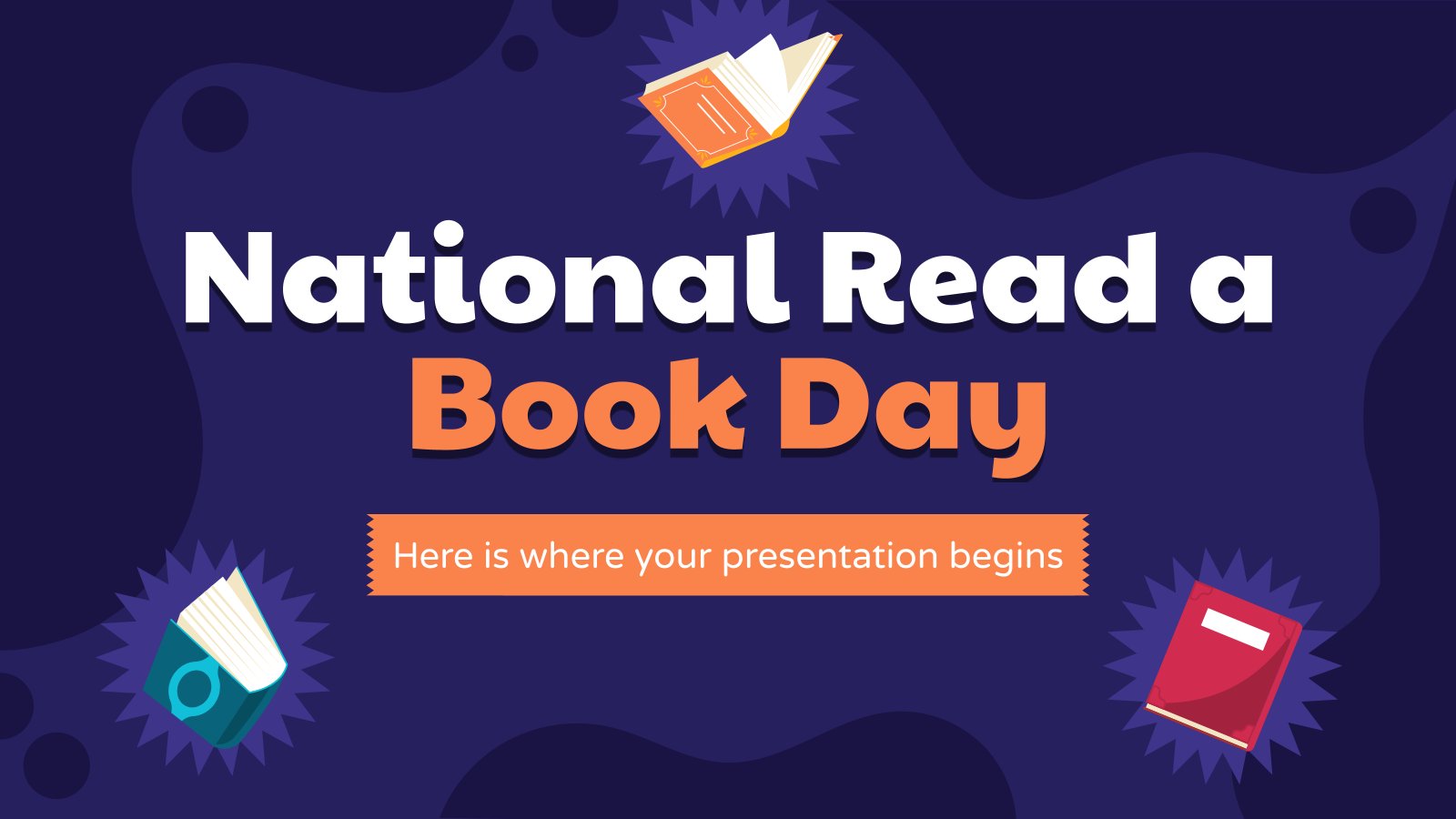
National Read a Book Day
Here at Slidesgo we think it's clear how important reading and books are for society, education and self-growth. Do you agree with us? Well, if you would like to encourage people to read more, how about you create a presentation for Read a Book Day? This funny template has all...
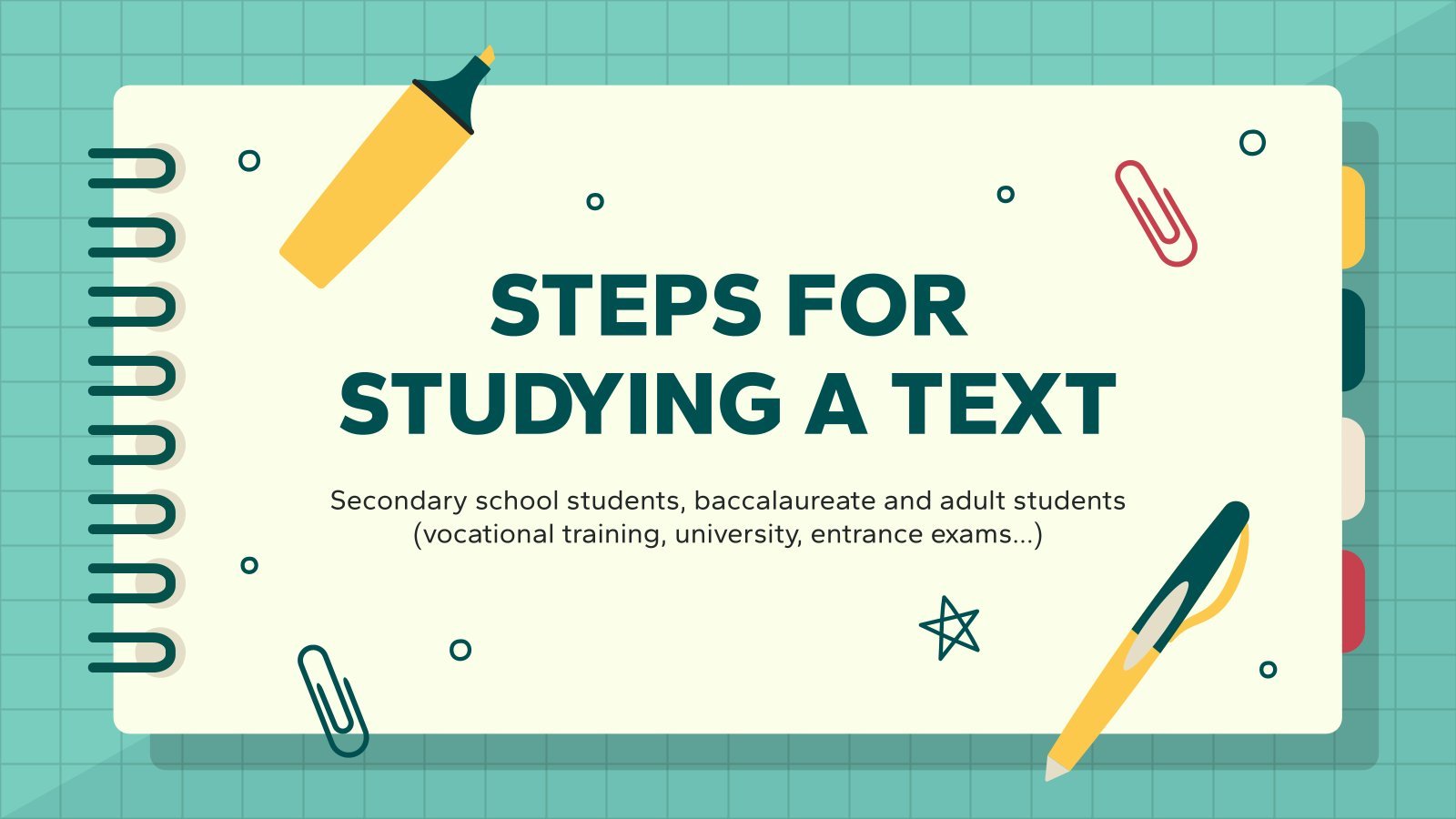
Steps for Studying a Text
Reading a book is good practice. Books are a source of knowledge! However, the complexity of the text you're reading affects the time you'll spend understanding it and memorizing it. That can be a problem when studying, so here's a template with some tips on how to face difficult texts...

How to Encourage Reading in High School: 3 Activities
Download the "How to Encourage Reading in High School: 3 Activities" presentation for PowerPoint or Google Slides. High school students are approaching adulthood, and therefore, this template’s design reflects the mature nature of their education. Customize the well-defined sections, integrate multimedia and interactive elements and allow space for research or...

Reading Skills Task Cards
We've designed this template for teachers who want to try some reading activities with their students. The slides look like pages of a notebook and they come with some examples of task cards that you can use in class. Its quite colorful and the titles appear as if they were...
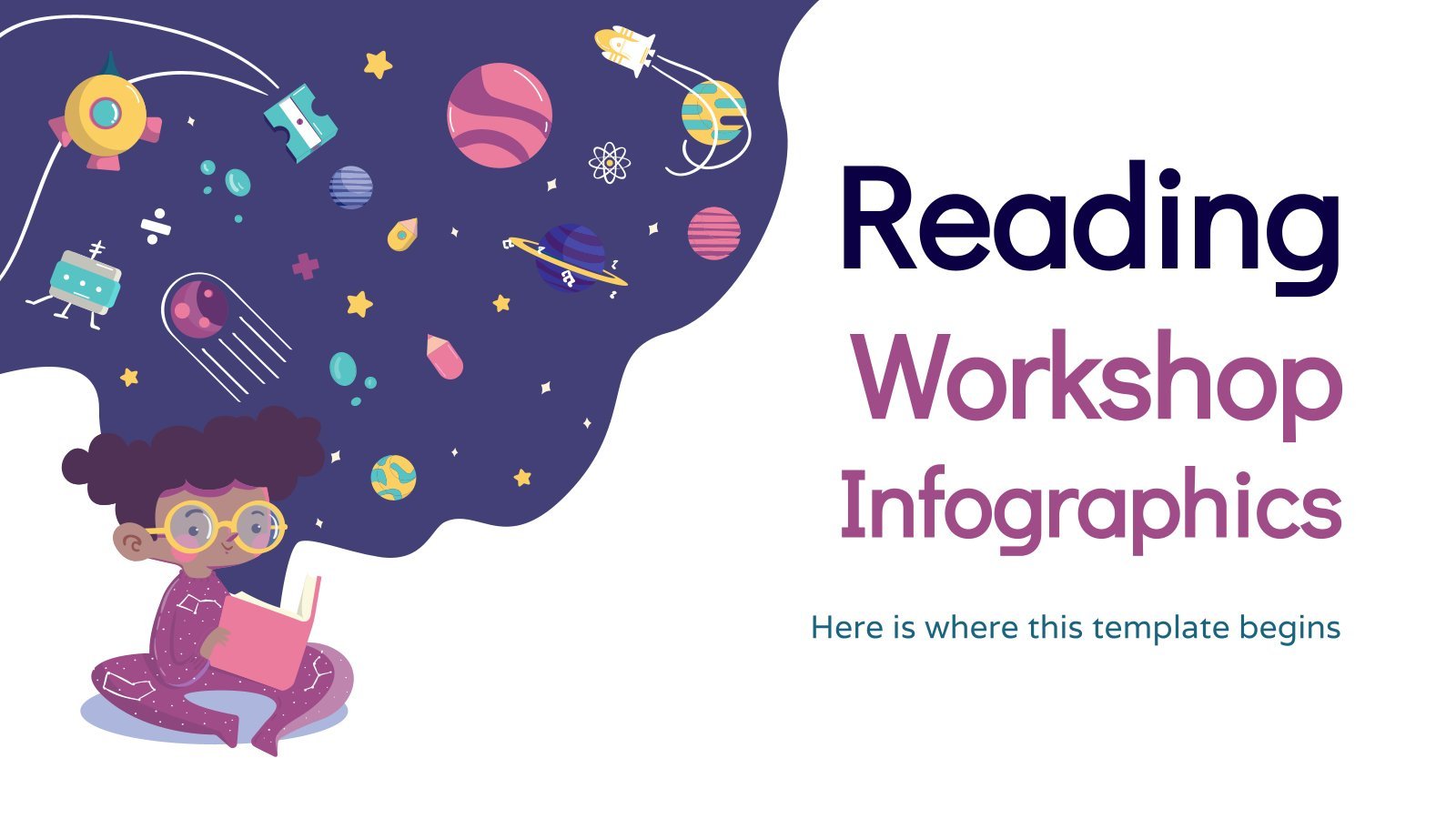
Reading Workshop Infographics
Download the "Reading Workshop Infographics" template for PowerPoint or Google Slides and discover the power of infographics. An infographic resource gives you the ability to showcase your content in a more visual way, which will make it easier for your audience to understand your topic. Slidesgo infographics like this set...

Quick Reading & Comprehension Skills
When teaching little kids, focusing on reading and comprehension skills will be so beneficial for them and, who knows, maybe they develop an interest in books over time! Use this cute template at the classroom and make your lesson more entertaining. The funny animals and the simple layouts will be...

Reading Fluency and Comprehension - Language Arts - 7th Grade
Help your seventh graders thrive in Language Arts with this editable study material, now available for Google Slides and PowerPoint. Creative and engaging, this presentation kit in cream, with bursts of vibrant color, covers the crucial elements of language. It provides various exercises that will hold their interest while reinforcing...
- Page 1 of 5
New! Make quick presentations with AI
Slidesgo AI presentation maker puts the power of design and creativity in your hands, so you can effortlessly craft stunning slideshows in minutes.

IMAGES
VIDEO
COMMENTS
The Elvian School was a private school in Reading, Berkshire, United Kingdom run by the Licensed Trade Charity as a co-educational, non-denominational Christian school. It was previously the Roman Catholic boys' school Presentation College, Reading, until it went into administration in 2004.In March 2010 it was announced that the school would close at the end of the academic year.
FALLING pupil numbers and a cash crisis are forcing one of Reading's top independent Catholic schools to close its doors. Presentation College in Southcote is due to make an official announcement ...
Presentation College accepts scores from the following exams. Scores must be sent directly to Presentation College from the testing agency in order to be counted as official. Score reports can be sent electronically or by postal mail to the Admissions Office. ... SAT: 490 Evidenced-Based Reading and Writing sub score. ACT: 18 English sub score ...
The Presentation Brothers, who are trustees of the school, agreed to accept a business plan - previously submitted by the school in March 2003 and rejected by the Order - with 'minor adjustments'.
About 12% of students accepted to Presentation College submitted their SAT scores. When looking at the 25th through the 75th percentile, SAT Evidence-Based Reading and Writing scores ranged between 420 and 560. Math scores were between 430 and 540. SAT Reading and Writing Scores for Presentation College ( 420 to 560 )
Presentation College has announced it will close in August 2004 because of falling pupil . ... Reading Festival 2024 line up headliners announced including Fred Again, Lana Del Rey, Blink-182 ...
This valuable technique is perfect for college reading. The title stands for Survey, Question, Read, Recite, Review, and you can use the steps on virtually any assigned passage. Designed by Francis Pleasant Robinson in his 1961 book Effective Study, the active reading strategy gives readers a systematic way to work through any reading material.
It could just be you talking intimately to a video camera, and letting the Internet do the rest. Presentation literacy isn't an optional extra for the few. It's a core skill for the twenty-first century. It's the most impactful way to share who you are and what you care about.
Presentation College is a private institution. Presentation College's ranking in the 2022-2023 edition of Best Colleges is Regional Colleges Midwest, #58-76. Its tuition and fees are $22,006. At-a-Glance. Setting.
Presentation College, Reading, Berkshire, now called Elvian School; United States. Presentation College, South Dakota, with a branch campus in Minnesota; See also. Presentation Brothers; Presentation High School (disambiguation) Presentation Sisters This page was last edited on 18 May ...
ED 109/8629/10. Description: Reading: Presentation College. Date: [1946-1955] Held by: The National Archives, Kew. Legal status: Public Record (s)
As of October 31, 2023, Presentation College has ceased educational operations at the Aberdeen, SD campus. Saint Ambrose University (SAU) is the contact for all student information. Please reference these web-pages for additional information. If you would like to request a transcript, you may contact the
December 17, 2019. New PowerPoints for Ten Steps to Improving College Reading Skills, 7/ e, are available now for downloading. To access these files, click here. You can also navigate to them by following this path: Materials ---> Supplements ---> Reading Series ---> Ten Steps to Improving College Reading Skills, 7/e ---> PowerPoint Files ...
Try the following techniques to make the most of your rehearsal sessions: Check. Do Not Read Your Presentation. While writing out a script can help you prepare, you shouldn't follow it word for word. Use images and text in your slides to remind you of key points you want to mention.
You will have more impact if your points are clear, simple, relevant, and direct. Beginning : Introduce yourself. Outline the aims of your talk and what you will cover in the presentation. Start with an attention grabber, such as a picture, an everyday example, or a rhetorical question. Middle : Your points should lead logically from each other.
Displaying latest 5 out of 9 topics See All. 5 Star Rating by a Student (1973 - present) by: Jonathan B ... 4 Star Rating by a Student (1966 - 1971) by: John Lane. 4 Star Rating by a Student (1971 - 1978) by: Philip Weeks. 3 Star Rating by a Student (2021 - present) by: Antony Lit ... 4 Star Rating by a Student (1970 - present) by: Joseph Kelly.
PowerPoint is an especially useful program for teaching text structure to college reading students. Discussion on how this may be accomplished, as well as directions for creating a presentation from the preexisting templates and backgrounds provided in the program are given.
The early history of Presentation College San Fernando begins in 1930, when a small school called St. Benedict's was established in a lowly basement beneath the San Fernando Presbytery at Harris Promenade This was the first Catholic Secondary school in South Trinidad, and was set up in response to the requests of the Catholic population as ...
Public speaking—giving an oral presentation before a class or another group of people—is a special form of interaction common in education. You will likely be asked to give a presentation in one of your classes at some point, and your future career may also involve public speaking. It's important to develop skills for this form of ...
Michael Bond was born in Newbury, Berkshire, England on 13th January 1926. He was educated at Presentation College, Reading. During World War II Michael Bond served in both the Royal Air Force and the Middlesex Regiment of the British Army. He began writing in 1945 and sold his first short story to a magazine called London Opinion.
Browse Getty Images' premium collection of high-quality, authentic Presentation College Reading stock photos, royalty-free images, and pictures. Presentation College Reading stock photos are available in a variety of sizes and formats to fit your needs.
Tip 4: Make use of charts and graphs. We all love a good stat. Charts and graphs are a great way to present quantitative evidence and confirm the legitimacy of your claims. They make your presentation more visually appealing and make your data more memorable too. But don't delve too deep into the details.
Download the "How to Encourage Reading in High School: 3 Activities" presentation for PowerPoint or Google Slides. High school students are approaching adulthood, and therefore, this template's design reflects the mature nature of their education. Customize the well-defined sections, integrate multimedia and interactive elements and allow ...
Dr. Victoria Rodrigo, a faculty member from the Department of World Languages & Cultures, recently hosted a Book Reading event for her Written Communications (SPAN 3302) students.During the event, the students presented their final project by reading their illustrated books to their peers. The event was held at CIRCLE and the students had a great time sharing their creative stories.